Music is the universal language
“Glory to God in the highest heaven, and on earth peace to those on whom his favor rests.” - Luke 2:14
Premier Guitar
Badlands Guitar Company Unveils the Limited Edition GX1-PRO Guitar
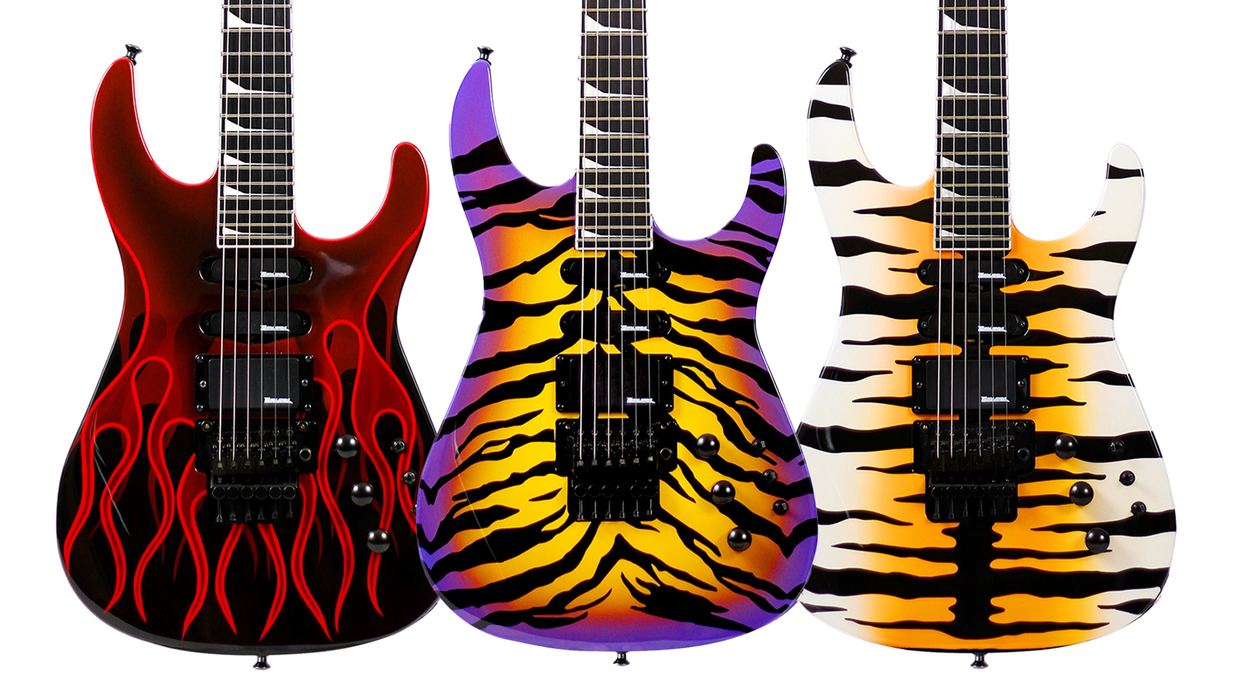
Limited to only 100 pieces, Badlands Guitar Company announces the release of its USA made GX1-PRO, available August 1 direct from the factory or at select retailers.
Purpose-built for players who came of age in the golden era of 1980s rock and metal, the GX1-PRO channels the high-octane spirit of that decade with custom-shop precision and modern performance refinements. Built exclusively in Maryland and available in either right or left-handed configurations, these arena rocking instruments fuse aggressive styling with hand-selected components for players seeking tone, playability, and attitude in equal measure.
The GX1-PRO features an alder body and a three-piece, quarter sawn maple neck-thru design, reinforced with carbon fiber rods and a dual-action truss rod to ensure exceptional sustain and resonance. The Custom series offers hand-painted finishes including Mystic Blue HotRod, Inferno Red HotRod, Sunset Bengal, and Retro Bengal. Available in the Classic series are solid finishes including Midnight Blue, Arrest Me Red, Taxi Yellow, and White Wedding Pearl. All finishes are polyurethane and an unmistakable homage to the high-octane visual style of the 80s. The 25.5” scale, ebony fretboard is loaded with 24 Jescar nickel silver frets and shaped with a compound radius of 12”-16”. Finished in matching paint, the ‘80’s select neck profile and 1 11/16” nut width provides comfort and easier playability. A tilt back headstock and Sperzel locking tuners improve sustain and tuning stability while Badlands Guitar Company's signature mother of pearl "Railroad Spikes" inlays and white binding add a touch of classic elegance.

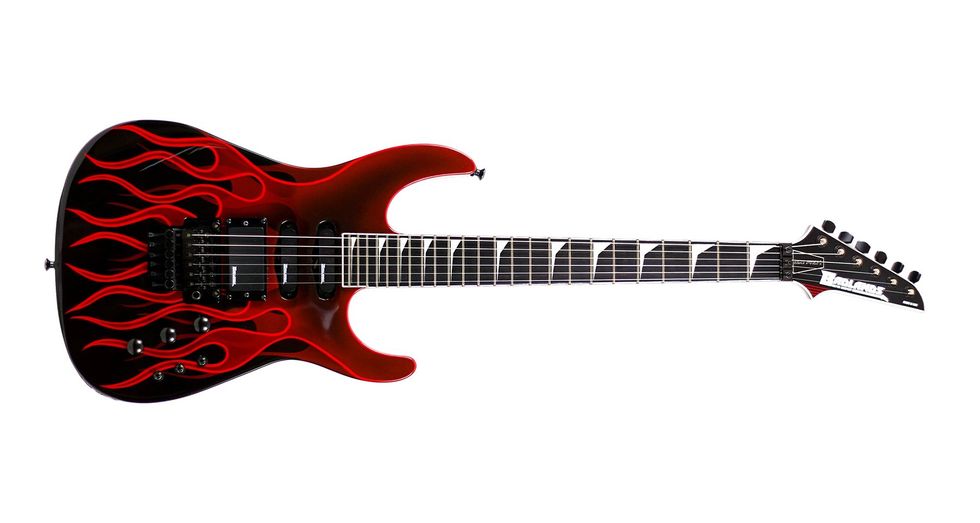


Just like any hot rod, custom paint is only half of the equation. What is under the hood is always what matters most. The GX1-PRO is engineered for powerful, versatile tones. Loaded with an H/S/S configuration, the custom-designed, handwound BGC M89 ceramic humbucker in the bridge position meticulously delivers an aggressive growl reminiscent of the era's most iconic high-performance pickups. This is perfectly complemented by two specially voiced BGC M81 single coils. The control layout features a trio of mini toggle switches, offering a wide array of tonal shaping options, consistent with classic 80s setups. A newly developed BGC1200M Midboost circuit, a first for Badlands Guitar Company, further expands the guitar's sonic palette, allowing players to dial in a diverse range of sounds from searing leads to articulate rhythm tones. The USA Floyd Rose bridge, locking nut, metal knurled knobs, and football jack cover are all appropriately finished in black.
Each GX1-PRO arrives set up with SIT Strings and ships with a premium embroidered Badlands G&G case, ensuring secure transport and protection. Case candy includes a Certificate of Authenticity, QC card, VIP Backstage Pass lanyard, pin and sticker set, a Dunlop System 65™ Multi-tool, and a limited edition framed poster uniquely matching the very guitar ordered.
For more information, please visit www.badlandsguitarcompany.com.
Street Price:
GX1-PRO Custom HSS $3499.00 USD
GX1-PRO Classic HSS $2999.00 USD
Tech 21 Killer Wail v2 Review
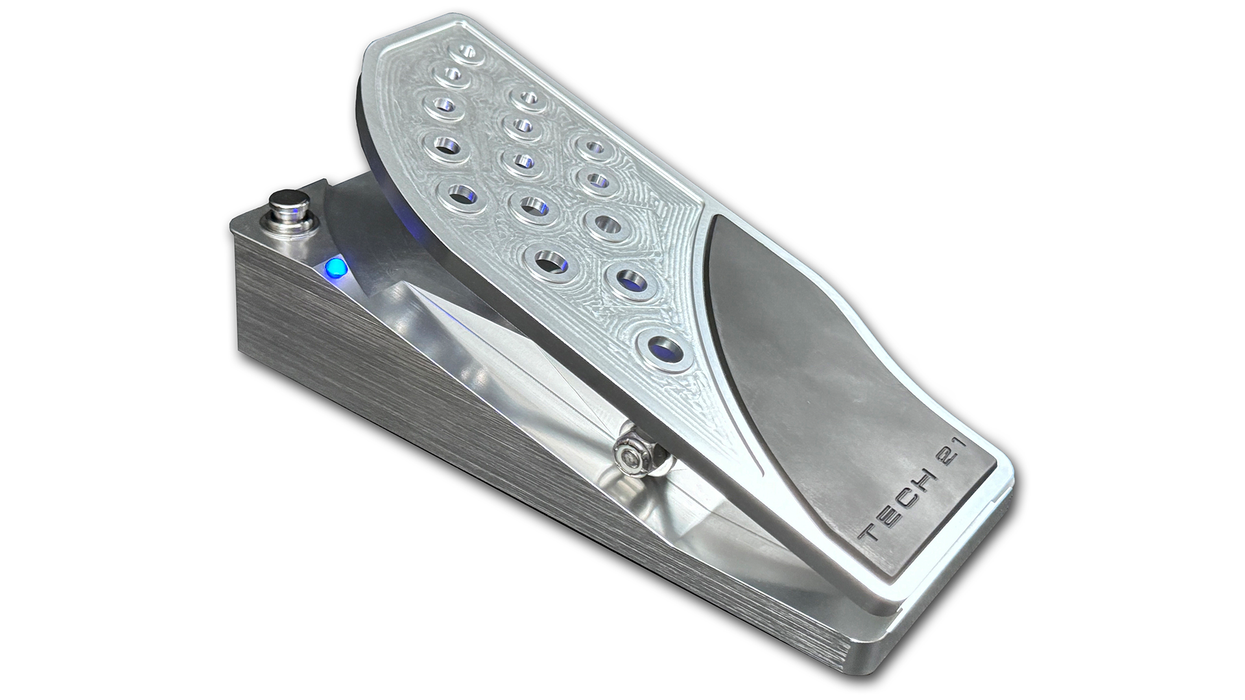
Tech 21’s original Killer Wail was an under-the-radar wah that gathered a great reputation among those in the know. After a complete redesign, Tech 21 released the Killer Wail v2, as well as two other wahs—the Richie Kotzen Signature wah and the Killer Blue Wail (for bassists). These are a significant departure from the original Killer Wail.
Machined from solid billet aluminum, the Killer Wail v2 is sturdy yet light. In fact, my Cry Baby weighs more than twice as much. It’s sleek—almost aerodynamic if such things were a consideration for wah pedals—with little of the bulk associated with conventional wahs. With its compact footprint and top-mounted jacks it’s also pedalboard friendly, a claim few wahs can make. It can also be operated via a 9V battery or DC power supply.
A Wah for Modern Times
A nice vintage wah exudes, well, mojo. That’s the nature of the effect, and a fact we can probably all agree on. But the mechanics of most wah designs come with downsides. The majority of wahs (vintage and modern) employ pots that tend to get noisy and scratchy, and if used heavily will ultimately need replacement. The Killer Wail v2 eliminates these issues by using a light sensor instead of wah pots. Theoretically, the light sensor will almost never wear out. This isn’t a new solution—Morley’s beastly chrome wahs from the 1970s famously employ optical sensors, and continue to do so. But they are a very practical—and quiet—alternative to conventional filter pots that tend to act like dust magnets.
Tech 21 also equips the wah with a silent buffered bypass switch positioned at the top left corner. A blue light beneath the button glows red when the pedal is engaged. According to Tech 21, the actuator is rated for a million uses, so durability shouldn’t be a concern.
The Killer Wail v2’s proprietary filter delivers a distinct feel. As expected, toe-down boosts the highs—but even without distortion, your tone stays rich and warm while still slicing through a band mix. Add a drive pedal after the wah, and that tonal character pays big dividends, yielding biting, aggressive, and warm tonalities that are ideal for screaming solos.
Heel-down, the pedal boosts the low end, creating a softened attack that lends sustained chords an almost Fender Rhodes-like feel. Engaging a drive pedal brought out creamy, vocal-like lead tones. Placing gain pedals before the wah allowed for slightly glitchy, synth-like sounds on single-note lines, in addition to more conventional percussive wah textures.
The Killer Wail v2 may not be the most budget-friendly wah out there, but its combination of long-term durability, expressive tone, and smooth, natural sweeps makes it feel like a solid investment—from heel to toe.
Berserker Electronics Launches the “Velcrow”
A fierce and flexible Gated Fuzz for modern players.
Berserker Electronics, creators of the Prehistoric Dog preamp and Aquanaut delay, has announced the release of their latest sonic weapon: Velcrow – a raw, percussive gated fuzz pedal designed for players who crave filthy textures with tight control.
Inspired by the beloved and discontinued Way Huge Conquistador, the Velcrow takes that sputtery, aggressive sound and pushes it further – offering more dynamic range, more usable tones, and a sharper, more responsive gate. Velcrow is built to deliver snarling fuzz with a snappy gate, thriving on punchy riffs, abrupt cutoffs, and glitchy sustain.
Despite its intensity Velcrow is also intuitive to dial in, with carefully tuned controls that let you shape your attack and decay without ever sounding flabby or buried.
Key features include:
- Inspired by the Way Huge Conquistador, but with expanded range and control
- Tightly gated fuzz with sharp attack and fast decay
- Simple, intuitive controls in a pedalboard-friendly enclosure
The Velcrow is available direct at www.berserkerpedals.com. Street price is $129.
Alan Sparhawk Gets By With a Little Help From His Friends
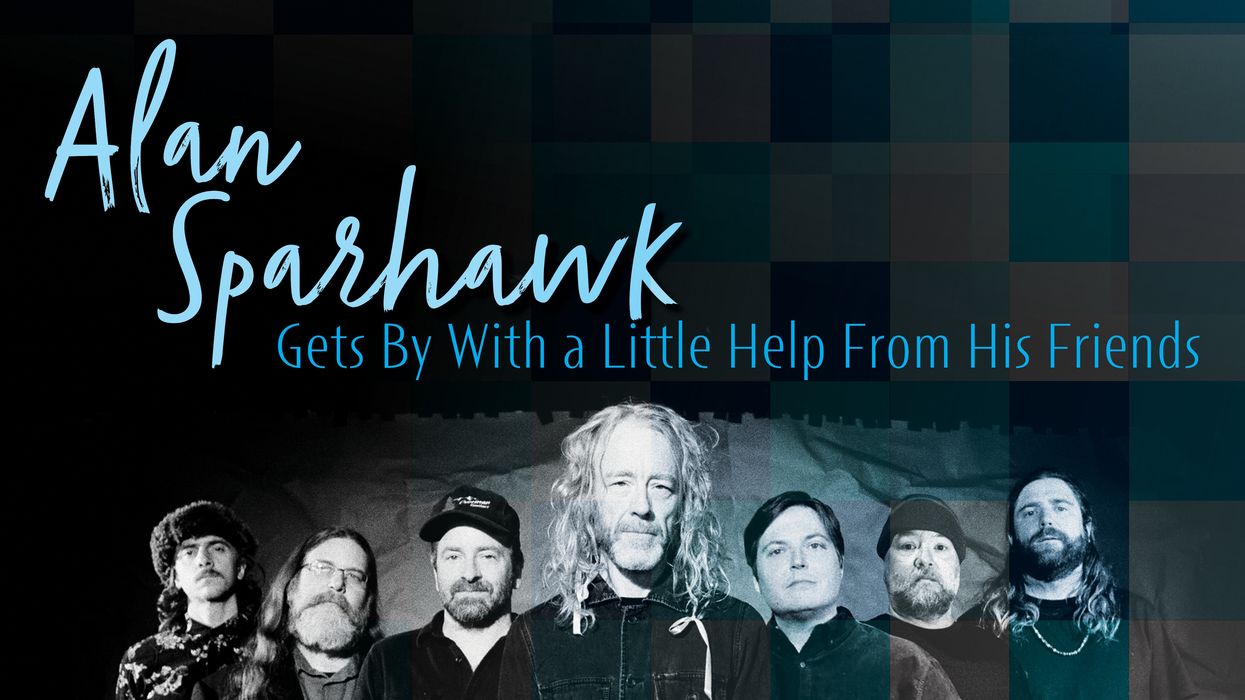
Alan Sparhawk has been a friend of Trampled By Turtles for a long time. Both parties came up in Duluth, Minnesota, and Low—Sparhawk’s often ethereal slowcore band with his wife, Mimi Parker, who died from ovarian cancer in late 2022—took Trampled By Turtles out on the road very early in the latter’s career. But few would’ve expected a studio collaboration between Sparhawk and the bluegrass merchants.
With Trampled By Turtles makes one wonder why. The record is deeply moving, often pulsing with powerful forward momentum, driven by Sparhawk’s unadorned voice like a herald calling out that something heavy this way comes. Of course, it arrives—especially in the bruised ecstasy of “Screaming Song” and the mournful “Don’t Take Your Light.”
“Some of the songs are the first things that fell out of me in response to loss and grief,” Sparhawk says over the phone from the Quad Cities, on tour with Circuit des Yeux. “Some of them are pretty pointed, and I really felt the duty to do those songs justice, to honor them for what they were and what they came from. White Roses, My God was literally just my head exploding and me running away from the guitar and from my voice and trying to figure out some way to let this explosion out of my skull, this screaming, you know? And this thing with the Turtles is the first breath.”

The two albums were recorded around the same time—even sharing the songs “Heaven” and “Get Still”—but they’re polar opposites, sonically. White Roses, My God trades in all-encompassing electronic soundscapes and so much vocal modulation that Sparhawk is unrecognizable, while With Trampled By Turtles feels stripped down, and features his voice rising clear above the bluegrass group’s earthy, mostly acoustic string work.
“It’s this unified wall of strings coming at you,” Sparhawk says about Trampled By Turtles. “There’s something egoless about the way they play together and the way they make sound. It doesn’t get broken down the same way a lot of bluegrass ensembles approach things.”
“I remember being still pretty scared and uncomfortable with my voice after years of singing with Mim and from the loss in general.”
After Parker died, Trampled By Turtles extended Sparhawk an invitation to hit the road for a few dates with them, an experience that brought the two closer and planted a seed that bloomed in Cannon Falls, Minnesota, in the winter of 2023. Sparhawk came in at the tail end of a Trampled By Turtles recording session there with a handful of songs, some old, some new, and the album came together swiftly. The result is a recording that foregrounds feeling, naturality, and spontaneity—more a pouring out than a piecing together. It’s often jarring how bare Sparhawk’s voice is, akin to an exposed nerve. It sounds more than a bit like a leap of faith, and he mentions that his only skill is diving into the unknown. “I’m quick to jump off the cliff,” he says.

“I remember being still pretty scared and uncomfortable with my voice after years of singing with Mim and from the loss in general,” Sparhawk says. “It really was making me feel very, very lost and awkward, singing. And I think during this Turtles thing—because this opportunity had come up and these guys had been so friendly and gracious with me—I consciously remember having to go, like, ‘I know I’m still not comfortable hearing my voice right now, but I have to just trust. I have to trust that this is what I can do, that I can sing, and that I’ve been working hard on this all my life. For the sake of the moment, put aside my confusion, and just trust that maybe five or six months down the line, I’ll be able to look back and decide whether I was comfortable with it or not.’ And honestly, it helped.”
“When I was a teenager, I remember very specifically saying that I like the guitar, and I really wanted to take it seriously, and I made a pact with myself to play it every day.”
It also marks a coming back to guitar for Sparhawk, the instrument that remains his “main physical connection to music.” But one needs to get away to come back. He thrives off of switching things up, much more able to see the big picture when he’s thrown into situations where he’s doing different things and forced to look at music differently. He says he struggles with the guitar, and has to practice often to stay fluent with what he wants to do. An opportunity to ponder something he hasn’t pondered, or play in a way that he hasn’t quite had to before, is always positive for him.
“I’ve always insisted on playing every day,” Sparhawk says. “When I was a teenager, I remember very specifically saying that I like the guitar, and I really wanted to take it seriously, and I made a pact with myself to play it every day. So it’s always there. It’s a world in my brain that I feel pretty happy in. But at the same time, I have to constantly be engaged with it to keep my footing there.”
Alan Sparhawk’s Gear
Guitars
1960s Danelectro Convertible
1970s Gibson Hummingbird
Amps
1960s Silvertone amp
Fender Pro Junior (small stages)
Fender Twin (large stages)
Effects
Chase Bliss Onward
Chase Bliss Mood
Red Panda Tensor
ZVEX Octane 3
ZVEX Box of Rock
Boss synth pedal
Tech 21 Double Drive
Strings
D’Addario strings (.011-.056)
His own approach to music-making and his musical community seems to be providing plenty of opportunity for challenges; the doomy goth-rock of Circuit Des Yeux sounds worlds apart from With Trampled By Turtles, which sounds worlds apart from White Roses, My God. And yet, it all exists in Sparhawk’s musical world—a world he says he feels blessed and grateful to be in, one that fascinated him as a child and that he wanted to be a part of. It’s given back in spades, too. Low, of course, was a family affair, and so is this new record, on which Sparhawk’s daughter, Hollis, also sings, during the chorus of “Not Broken.” One gets the feeling that connection has always been the point.
“Anyone who’s been blessed with friends that are there for them when they’ve had losses—those are the most important things in life,” Sparhawk says. “I think music is there to remind us of that, and give us a really amazing opportunity to feel that with each other and to bless each other.”
YouTube
Lose yourself in this peaceful, psychedelic rendering of “Get Still,” off of With Trampled by Turtles.
When Dave Grohl Used an Amp in a Gas Can to Make Foo Fighters’ Lo-Fi Debut
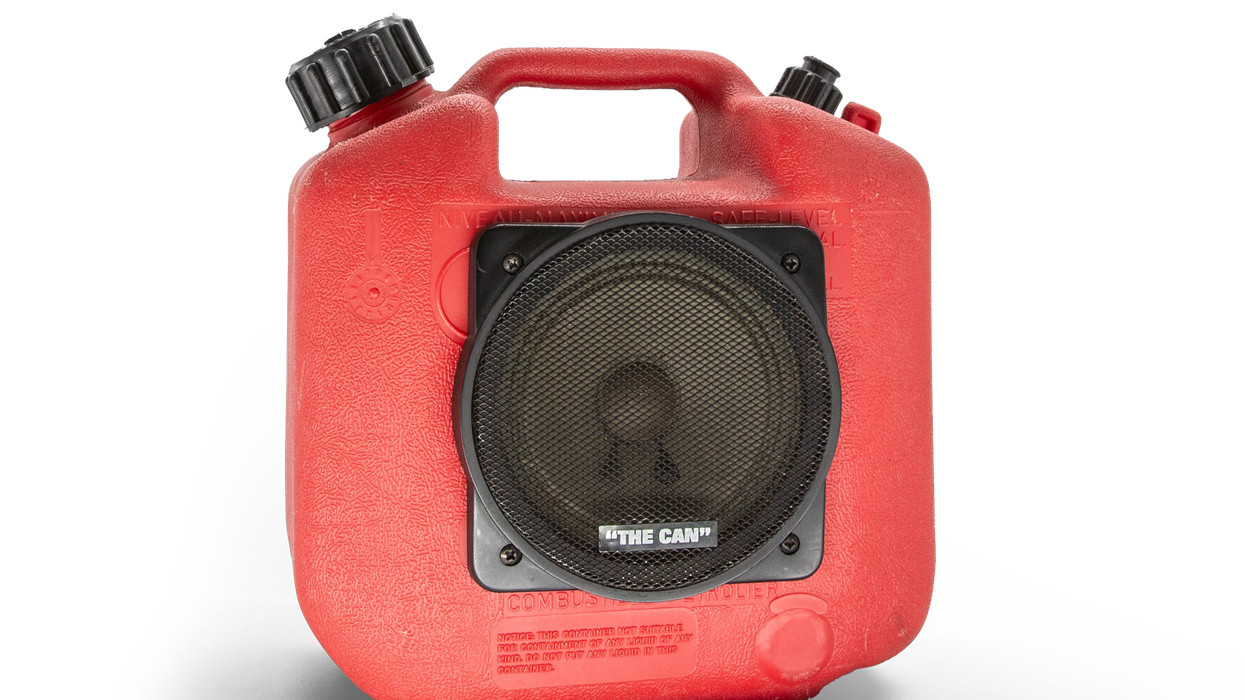
This year, the Foo Fighters’ self-titled debut turns 30 years old. As a nearly obsessed fan of the band since 2011’s Wasting Light, I’ve developed an exceptionally strong attachment to the first album. By now, we all know the story: Following the tragic and sudden end of Nirvana, Dave Grohl found himself searching for the right way to start making music again. In October 1994, he booked a week at Robert Lang Studios in Seattle, Washington, with producer Barrett Jones, and they got to work recording what would become the debut Foo Fighters album. This release would serve as the foundation for the band’s tenure at the forefront of modern rock for decades to come.
There is something uniquely nostalgic and spontaneous about the sound of Foo Fighters. The crunchy guitars and uptempo beats are straight off the heels of the grunge movement, with elements of punk and metal—staples of Grohl’s musical influences growing up—plus a sweet, melancholy shoegaze vibe, which permeates songs like “Floaty” and “X-Static.” These recordings are lo-fi, but still deliberate and precise, a testament to both Grohl’s skill as a musician as well as the limited session time allotted to complete the album.
The gear used to record this album has always been an intriguing mystery to me, and one piece specifically kept popping up in my research: an amp known as the Can. Over the years, both Grohl and Jones have cryptically mentioned a mythical amplifier that provided the most glorious, disgustingly raunchy fuzz tones, heard most notably on closing track “Exhausted.” For a long time, fans online talked about a “gas-can amp,” an “oil-can amp,” or even some claiming the effect was achieved by placing a microphone into a metal can next to a guitar amp—nobody was quite sure what exactly the source of this sound was.
In 2021, Jones hosted an “ask me anything” live stream on his YouTube channel. I was lucky enough to catch it, and the first question I asked was about this mystery amp. That’s when I first laid my eyes on the Can. It’s literally what it sounds like: a small, battery-powered practice amp built into a red plastic Jerry can. My mind was blown; I needed to know more.
“I had to take a moment to step back from the situation and admire how silly it was to be so excited about this; objectively, this amp sounds terrible, like a swarm of bees rattling around in a plastic jug.”
The story goes that SLM Electronics, an amp-manufacturing division of St. Louis Music, produced these amps in the mid ’80s as a battery-powered solution for buskers. As a novelty, they created a plastic enclosure that resembles a plastic gas can for the solid-state amplifier controls as well as the 5" speaker. Approximately 10,000 of these amps were manufactured and distributed out of the same factory where the original Crate amps were made in the U.S.
Once I learned exactly what this amp was, my mission became clear: I needed one.
I quickly discovered how difficult it is to find these amps. Even as a seasoned gear-hound, well-acquainted with the standard practice of scouring Reverb, eBay, Musician’s Friend, and every other source where used musical equipment can be found, I was coming up empty-handed. My searches resulted in a few expired Reverb listings from years earlier of people selling these amps for dirt cheap, which, while frustrating, yielded an encouraging sign that the lore behind “the Can” was not yet common knowledge. My worst fear was that word would get out about these amps and we’d end up with another instance of PDS: Peavey Decade Syndrome. (If you know, you know.)
In a turn of miraculous serendipity, I stumbled across someone selling one on Facebook Marketplace and jumped on it. I’d managed to snag my very own Can amp. I had to take a moment to step back from the situation and admire how silly it was to be so excited about this; objectively, this amp sounds terrible, like a swarm of bees rattling around in a plastic jug. However, when I finally plugged in my guitar for the first time and strummed that first D minor chord from “Exhausted,” I knew immediately: That’s the sound.
The simple truth I’ve come to terms with over the years as a guitarist is that “good tone” is purely subjective. Especially in a studio setting, some of the most iconic sounds can be uncovered in the most unconventional ways, and the Can is a true testament to that statement. While the early days of Foo Fighters were undoubtedly cast in the looming shadow of Nirvana’s massive success and catastrophic end, I think it’s finally time we recognize Grohl’s 1995 solo effort for what it is: a truly magical little slice of mid-’90s post-grunge that still packs a mighty wallop 30 years later. And in the middle of it all, this crunchy, fizzy, horrible little gas-can amp.
This Will Destroy You Rig Rundown
The doomgaze titans from Texas hit the road this year to celebrate more than two decades together, and they brought some of their favorite noisemakers for the occasion.
Post-rock/doomgaze outfit This Will Destroy You, formed in San Marcos, Texas, in 2004, are marking 21 years together, and 20 years of their self-recorded debut Young Mountain, with an anniversary tour. In late June, the band played Nashville’s Basement East, where guitarists Jeremy Galindo and Nicholas Huft and bassist Ethan Billips met up with PG’s Chris Kies to share what gear they packed for the roadtrip.
Brought to you by D’Addario
Trusty Tele
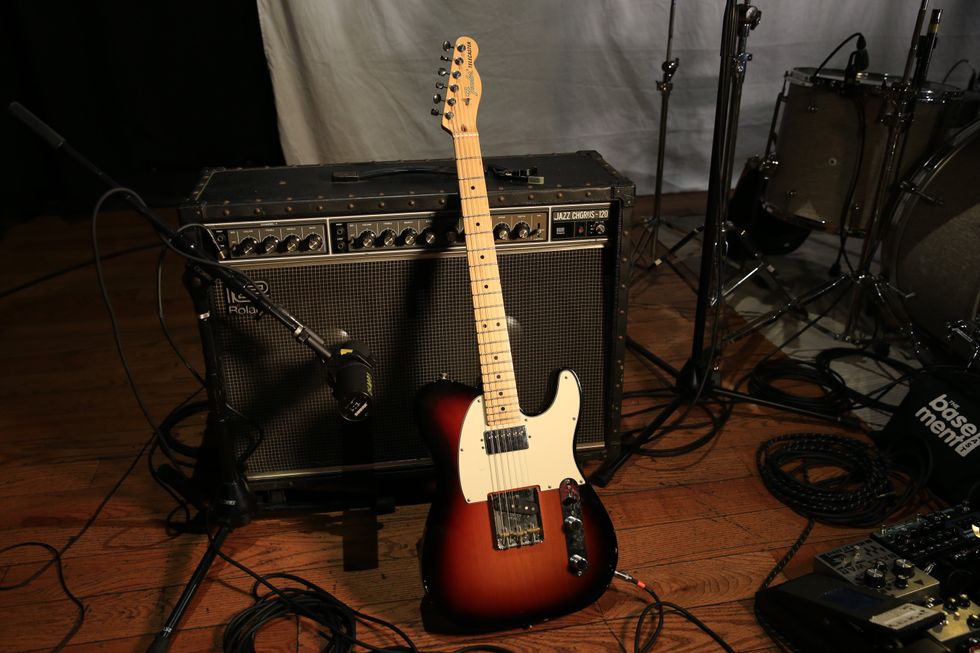
Galindo started off playing electric on his brother’s Fender Telecaster, and he’s never looked back. He’s played various models over the years, but got this Fender American Performer Telecaster two years ago. He strings it with .011–.052 strings for slightly more body and fullness, and tunes it to E-flat standard. Galindo mostly plays with his fingers, but when he picks he uses some of the thinnest picks he can find.
No Tubes? No Problems
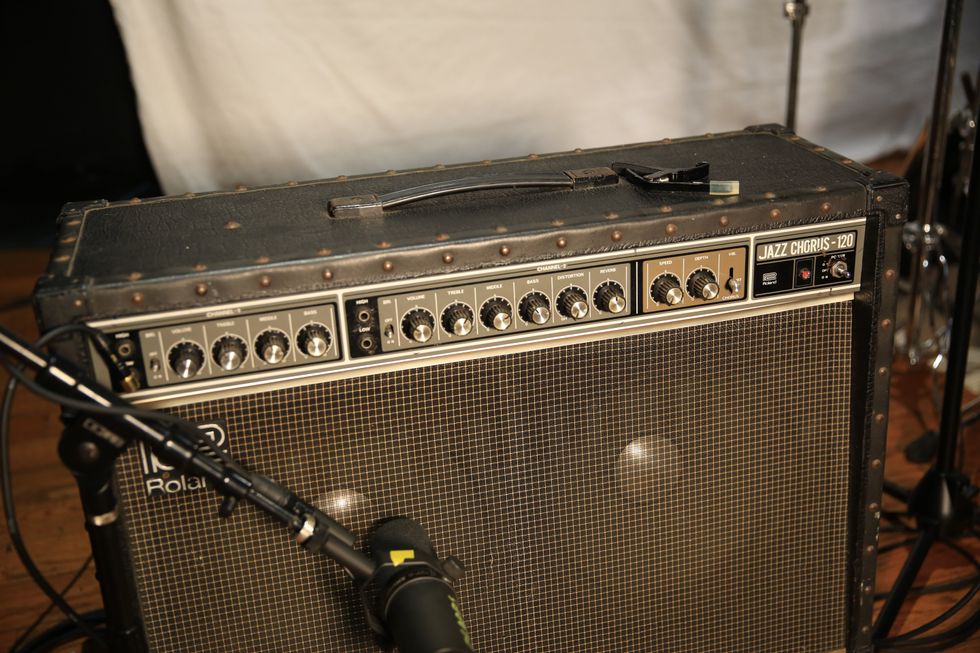
A Music Man HD-130 is Galindo’s always-and-forever, but on the road, he likes this Roland Jazz Chorus 120 for its tubeless reliability and easy clean sounds.
Jeremy Galindo’s Pedalboard
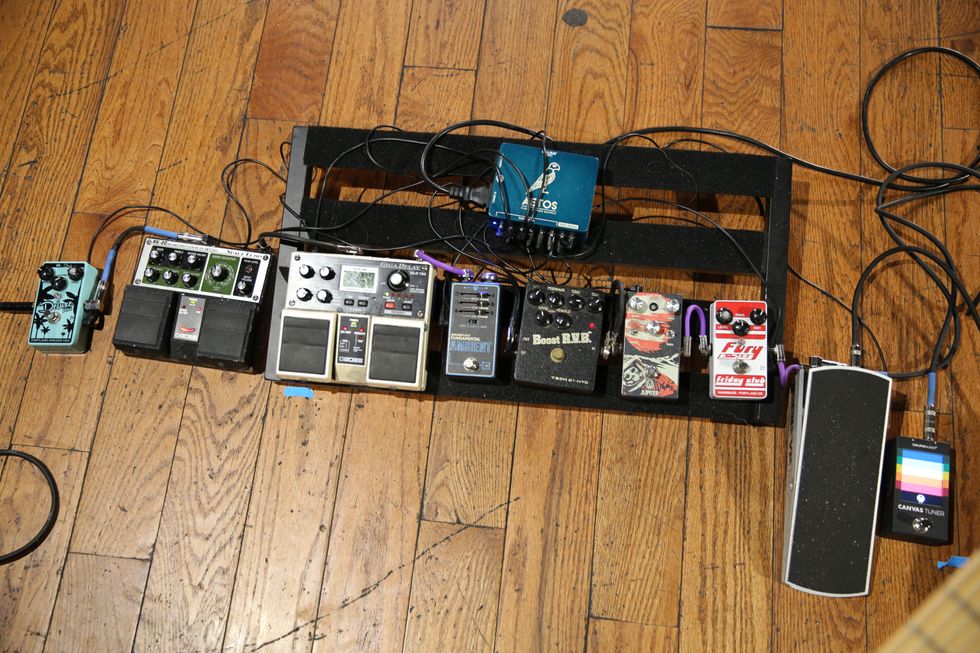
The Boss DD-20 Giga Delay and Tech 21 Boost R.V.B. have been with Galindo since the early days, and he considers the Tech 21 to be the most essential tool of his kit. Aside from those, there’s a Walrus Canvas Tuner, Ernie Ball VP JR, Friday Club Fury 6-Six, Walrus Jupiter, Walrus Fundamental Ambient, Boss RE-20, and Mr. Black Deluxe Plus. A Walrus Aetos powers the party.
Smooth as Sandpaper

This Fender Jazzmaster, Huft’s first, was bought from Full of Hell guitarist Spencer Hazard, who equipped it with its “awful sandpaper texture” finish. Huft doesn’t use the rhythm circuit, so he’s taped it off. He plays with both pickups engaged at all times, including the humbucker rail pickup in the bridge.
United Solid-States
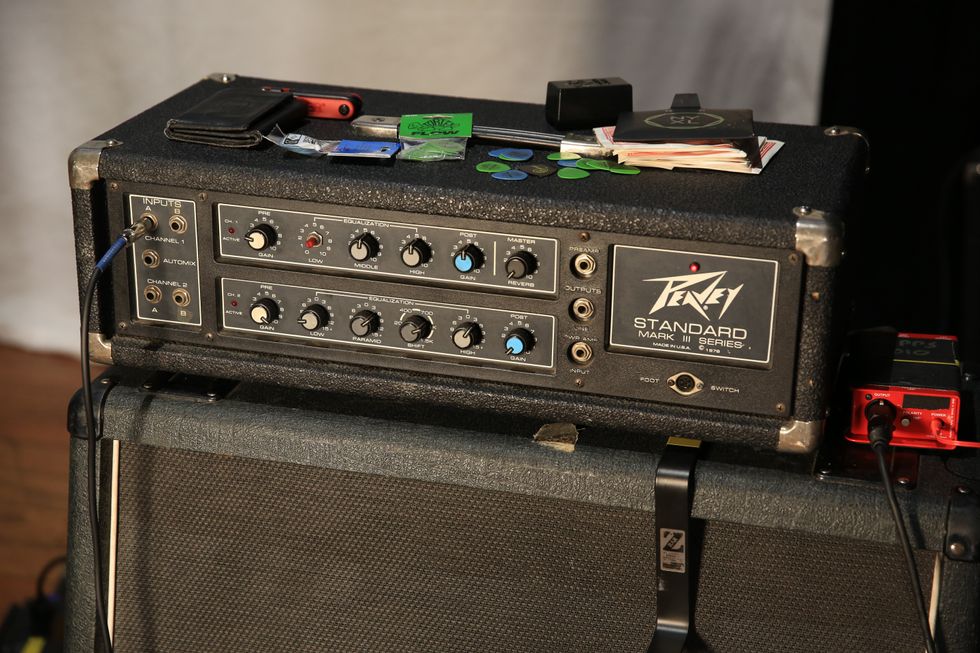
Huft has a soft spot for 1970s solid-state amplification, which makes this Peavey Standard Mark III series a perfect match for TWDY: It’s cheap, and it’s loud.
Nicholas Huft’s Pedalboard
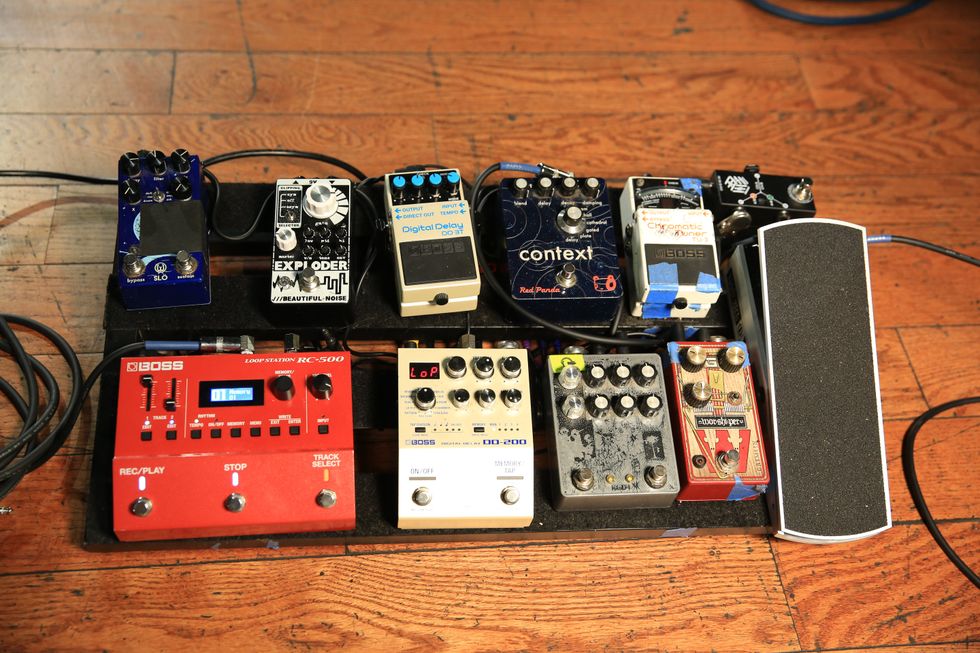
Along with an ABY switcher, Huft runs a Boss TU-3, Ernie Ball VP JR, Gremlin Machine Shop Worshiper, Dead Air Portrayal of Guilt/Matt King Dual Drive, Boss DD-200, Boss RC-500, Red Panda Context, Boss DD-3T, Beautiful Noise Exploder, and Walrus Slo.
Cheap and Cheerful
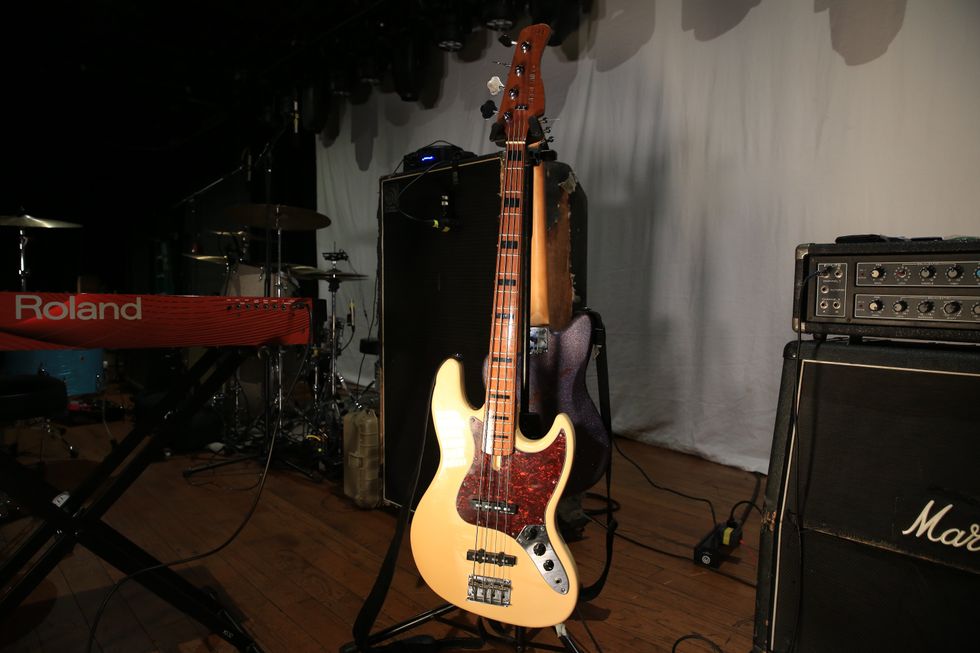
Billips explains that he and his bandmates grew up on cheap instruments, and they still feel like home, so that’s why he rocks with this Marcus Miller Sire bass.
Community Cranker
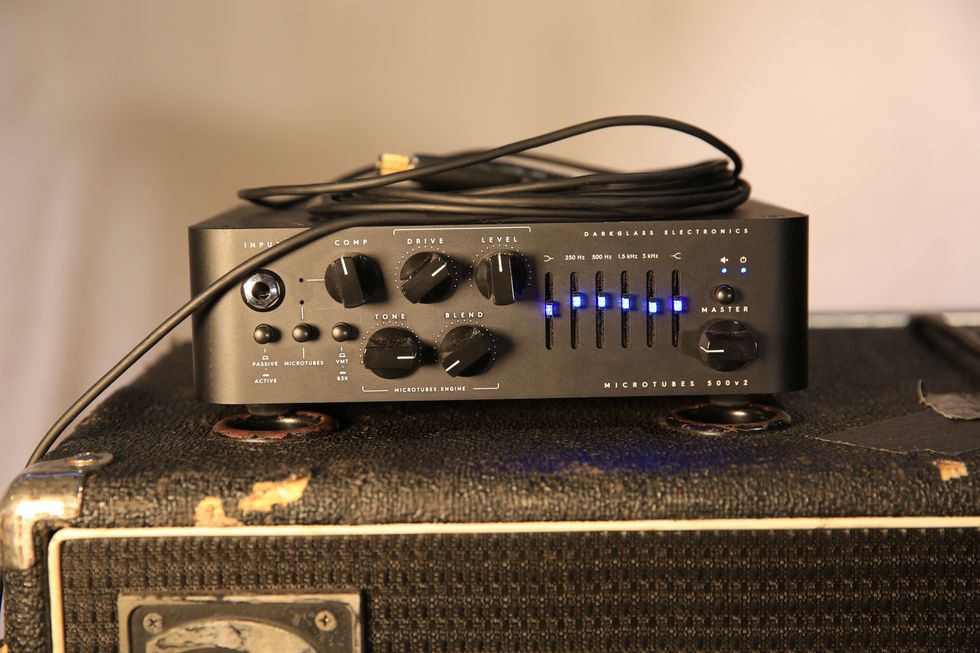
Billips and his bandmates split on this Darkglass Electronics Microtubes 500 v2 head, which they share collectively.
Ethan Billips’ Pedalboard
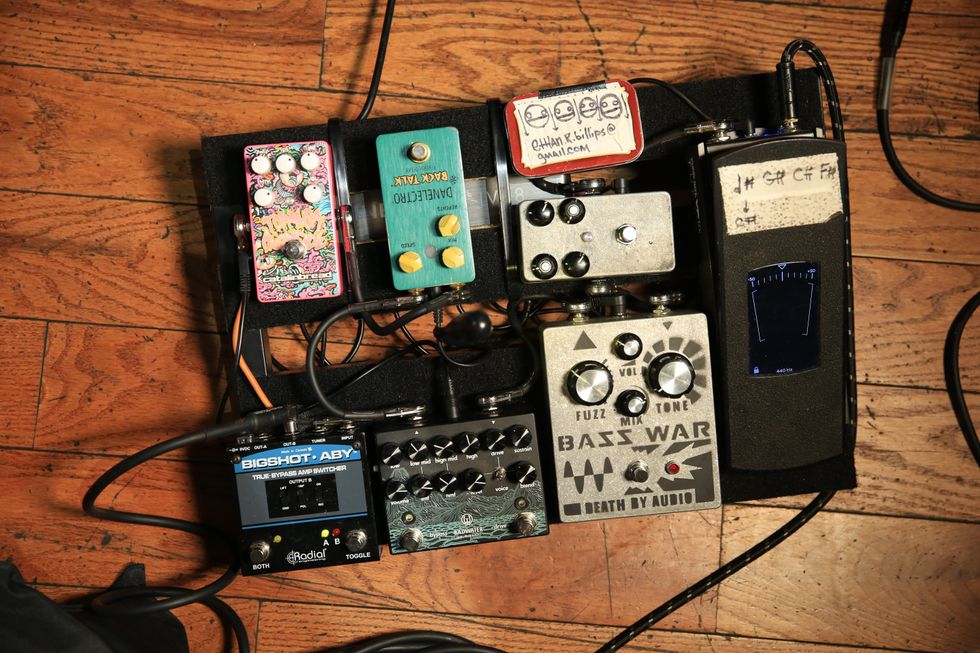
Billips runs an Ernie Ball VP JR Tuner, a prototype bass overdrive from Mr. Black, a Death by Audio Bass War, Walrus Badwater, Danelectro Talk Back, Catalinbread Topanga, and a Radial BigShot ABY.

Be More Like Led Zeppelin
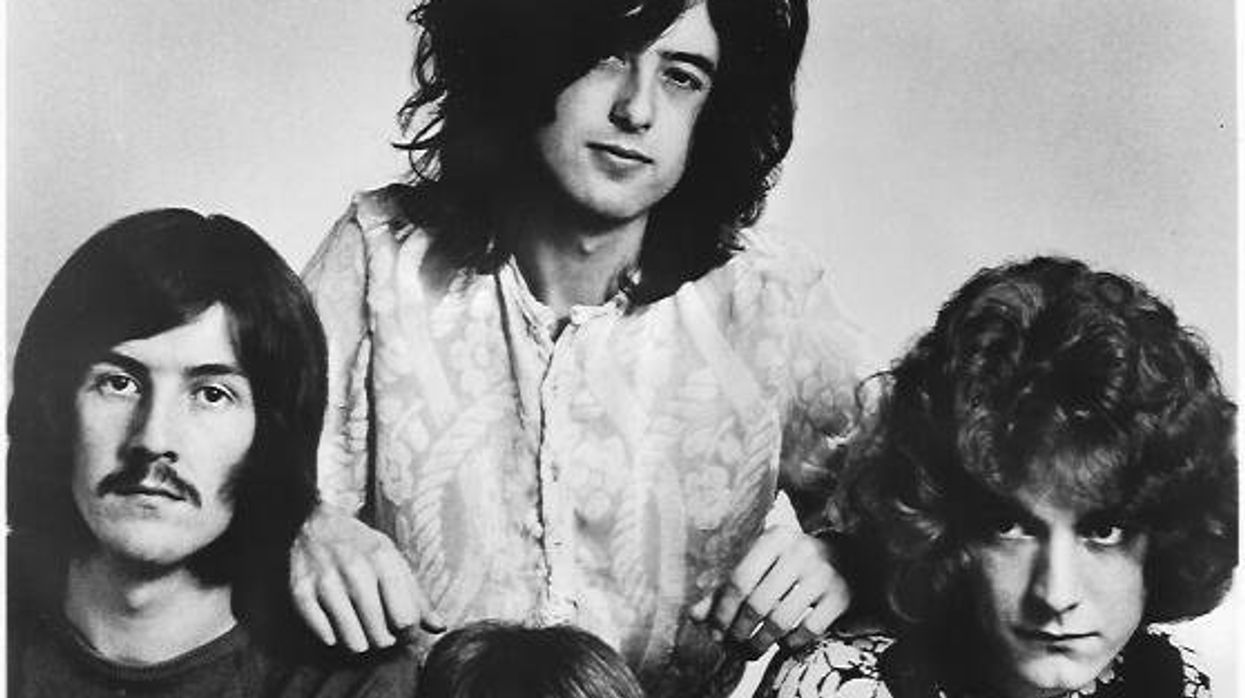
Making great music requires pushing the envelope, not pushing buttons.
As a teen, I signed over my soul to the Columbia House mail-order mafia and bought the first few Led Zeppelin albums. I wore those albums out, dropping the needle in front of the “Heartbreaker” solo, “Black Dog,” and “Stairway” daily. Eventually I moved on to other obsessions and forgot how amazing this band was—until last night, when I watched Becoming Led Zeppelin, Bernard MacMahon’s 2025 documentary. The film, which earned a 10-minute ovation at the Venice Film Festival and grossed $13.2-million by May 2025, charts the explosive rise of Jimmy Page, Robert Plant, John Paul Jones, and John Bonham from their 1968 formation to 1970’s global dominance.
Although Page and Jones had worked together as session musicians, the first time the Zep lineup played music together was a jam in a tiny, rented rehearsal room in 1968. They tested their collective sound, starting with blues standards like “Train Kept A-Rollin’” and “Smokestack Lightning.” Forty-four days later, they were recording their first album, which they completed in 36 studio hours. This raw fusion of blues, rock, and psychedelic chaos, using a 4-track recorder and a shoestring budget of £1,800 (about $4,300, then), helped usher along a paradigm shift in music. Tracks like “Dazed and Confused” and “Good Times Bad Times” took wild risks, blending modal riffs, orchestral swells, and improvisational fire. Led Zeppelin was also incredibly diverse, with the heavy blues balanced by the acoustic “Black Mountain Side,” which was inspired by folk and Indian music. Zep II pushed further, from the primal riff of “Whole Lotta Love” to the semi-pastoral “Ramble On.” Page’s violin bow on guitar and Bonham’s heavier-than-heavy drumming defied norms, while Plant’s primal vocals careened between octaves.
Most of today’s modern music is polished to predictability, sterilized, and quantized. I bet that 99 percent of the sessions I’ve played on over the past two decades were all built on a grid with a stagnant click. Zep’s approach to tempos is more like classical music, where the tempo follows the emotion. “Dazed and Confused” starts with a slow, brooding tempo (around 60 to 70 bpm) driven by a descending bassline and Page’s eerie guitar. The middle section accelerates into a frenetic jam (around 120 to 140 bpm), with Bonham’s aggressive drumming and Page’s wild soloing, before slowing back down for the haunting violin-bow section and a final explosive ramp-up to 140 bpm. On “Babe I’m Gonna Leave You,” the transitions are so abrupt it feels like a car ran a red light and hit your passenger door. Zep would have been boring if they were constrained by a click.“If ‘Stairway to Heaven’ debuted today, would anybody hear it?”
Zeppelin’s tones and timbres also kept it unpredictable and endlessly interesting. Although John Paul Jones’ ’62 Jazz bass, Bonham’s Ludwig Super Classic, and Page’s guitars did most of the heavy lifting, Zep gave us vast sonic variety. Between the four members, they played 15 instruments on their first three albums and went to great lengths to make every song its own, unique sound. Yet, regardless of the instrumentation, Zeppelin always sounds like Zeppelin.
Rock ’n’ roll was built on experimentation and rebellion. It’s truly a DIY genre. So how did modern rock become so homogeneous and tame? Today’s unlimited digital tracks and AI tools (used in 60 percent of 2024’s Top 40, according to MusicTech.com) encourage overproduction, smoothing all quirks along the way. Radio and streaming exacerbate this as labels push 3-minute singles with hooks in 30 seconds to fit ad-heavy radio and prevent Spotify skips. Zeppelin’s era had FM stations playing 7-minute epics. Today, labels prioritize safe bets, favoring formulaic hits over risks. Social media and streaming reward conformity—songs must grab instantly, not unfold like a movie. If “Stairway to Heaven” debuted today, would anybody hear it?
By comparison, the 1960s were an incredibly open-minded time. Labels were looking for something to take a chance on because the outliers were paying off. The Beatles, Bob Dylan, and Hendrix successfully took chances, which enabled others like Zep to push the envelope farther, paving the way for yet more experimental artists like Bowie and Van Halen. The last boundary stretcher was probably Nirvana. That was 34 years ago.
There’s tons of amazing music being made today. But there’s also a whole lot of trend following rather than trend setting. Now that AI is writing/producing/creating music, that’s not going to diversify the mainstream. Becoming Led Zeppelin reminds us that music thrives on urgency and daring. Take chances.David Gilmour 'Live at the Circus Maximus, Rome' Live Film in Theatres September 17
The forthcoming David Gilmour live album and film entitled THE LUCK AND STRANGE CONCERTS and LIVE AT THE CIRCUS MAXIMUS, ROME, beautifully capture the 2024 Luck and Strange tour.
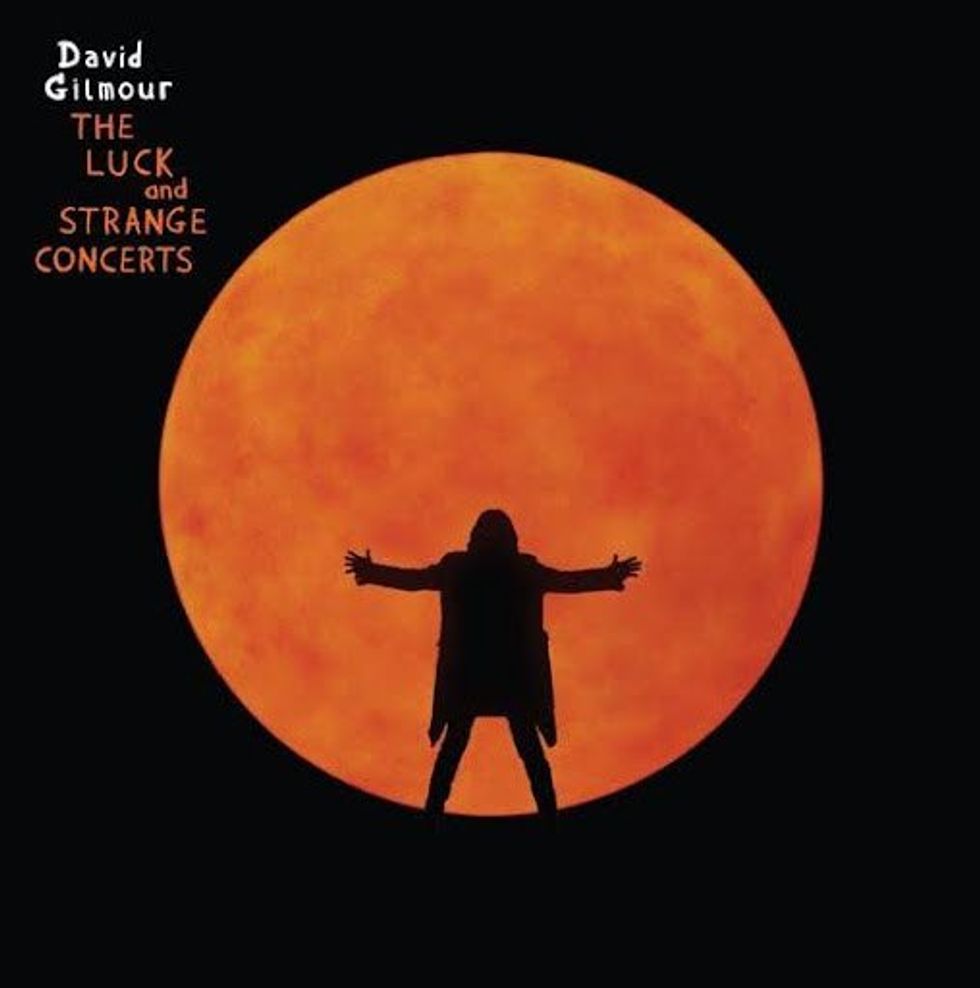
The tour accompanied Gilmour’s fifth solo album, LUCK AND STRANGE, which hit #1 in the UK, Germany (his first #1 there), Poland, Netherlands, Czech Republic, Switzerland, Portugal and Austria. It reached #2 in France, Italy, and Belgium, the top 5 in Spain, Japan, Norway, Denmark, and Hungary, and the top ten in the USA, Australia, Finland, Sweden, Ireland, and New Zealand.
The shows began with two sold-out warm-up shows at the Brighton Centre before moving to Circus Maximus in Rome for six sold-out nights, followed by the same at London's Royal Albert Hall before moving Stateside for sold-out evenings at the Intuit Dome and Hollywood Bowl in Los Angeles, before concluding with five sold-out nights at Madison Square Garden in New York.
All twenty-three dates were sold out, and with no new shows on the horizon, THE LUCK AND STRANGE CONCERTS and LIVE AT THE CIRCUS MAXIMUS, ROME is the best and only way to experience the master of his art on stage.
LIVE AT THE CIRCUS MAXIMUS, ROME, which is being released via Sony Music Vision and Trafalgar Releasing, will be shown in cinemas & IMAX worldwide on 17th September for a limited time only. The film sees Gilmour return to Rome's historic Circus Maximus at the beginning of the Luck and Strange tour, his first in nearly a decade. Long-time Gilmour collaborator Gavin Elder filmed the sublime spectacle against the backdrop of the ancient ruins of Rome. Tickets at cinemas around the world will go on sale 6th August at 2pm BST/ 9am EDT / 6am PDT. Full screening details for both IMAX and standard format cinemas will be available at davidgilmour.film. LIVE AT THE CIRCUS MAXIMUS will also be released on 2 Blu-Ray and 3 DVD sets with bonus unseen footage and the full THE LUCK AND STRANGE CONCERTS mixed in 5.1 and Atmos (Blu-Ray only) on 17th October.
THE LUCK AND STRANGE CONCERTS features 23 tracks across 4LPs or 2CDs recorded at selected shows from the tour and blends solo tracks from David’s most recent album, including a stirring rendition of Between Two Points with Romany Gilmour as well as classic Pink Floyd anthems such as Sorrow, High Hopes, Breathe (In The Air), Time, Wish You Were Here, and Comfortably Numb. The super deluxe edition of the album features all the formats as well as a 120-page hardback book, DAVID GILMOUR LUCK AND STRANGE LIVE, featuring Polly Samson’s photographs taken on the tour.
The audio for THE LUCK AND STRANGE CONCERTS and LIVE AT THE CIRCUS MAXIMUS, ROME has been co-produced by David and Charlie Andrew, who co-produced the Luck and Strange album.
For the lucky fans who experienced these once-in-a-lifetime shows, THE LUCK AND STRANGE CONCERTS and LIVE AT THE CIRCUS MAXIMUS are the perfect reminders of Gilmour’s soulful, expressive, and meticulously melodic guitar playing and the brilliance of his incredible band. For those who missed the shows, the album and the film offer a once-in-a-lifetime chance to experience this extraordinary musical event.
One-Stop Polished Acoustic Tone: L.R. Baggs Align Series Demo with Zach Wish
Zach Wish puts the L.R. Baggs Align Series pedals through their paces on his personal AEG-1 acoustic, demonstrating how each pedal brings studio‑quality effects to your DI signal. Hear the Session, Chorus, Delay, and Reverb in action and watch Zach dial in a pro-level tones from a compact package. Whether you want a simple, all‑in‑one acoustic board or individual pedals to suit your rig, the Align Series is ready to strum.
LR Baggs Align Session Acoustic Saturation/Compressor/EQ Pedal
Align Session Pedal
LR Baggs Align Chorus Acoustic Chorus Pedal
Align Chorus Pedal
LR Baggs Align Delay Acoustic Delay Pedal
Align Delay Pedal
LR Baggs Align Reverb Acoustic Reverb Pedal
Align Reverb Pedal
RhPf Electronics Unleashes Mosferatwo Mosfet Overdrive
RhPf Electronics has unveiled the Mosferatwo, a handcrafted MOSFET overdrive pedal designed for players who want to sculpt saturated tones with clarity, nuance, and punch.
Built around a 100% original circuit, it delivers everything from clean boost to greasy fuzz through a stack of carefully voiced gain stages and precision EQ shaping — all with the touch sensitivity and harmonic richness of a cranked tube amp.
- Dual-stage Drive control: One knob, two gain stages — for smooth transitions from subtle grit to snarling overdrive.
- Interactive Focus control: Shapes both dynamic feel and frequency response — bold and bloomy to tight and articulate.
Initially designed with gritty garage-blues duos in mind — where a single guitar needs to fill the entire sonic spectrum — Mosferatwo has since earned praise from a wide range of players for its amp-like response and bold, characterful voice. It’s already landed on boards across styles, from raw vintage blues to modern fuzzed-out riffing.
Like all RhPf Electronics creations, Mosferatwo is not a clone, mod, or tweak — it’s a fresh, fully original circuit built from the ground up.
Street price is $179. They’re available at select retailers and can also be purchased directly from the RhPf Electronics online store at rhpfelectronics.com.
Xvive announces H3 Transmitter Holder for the A58 and P58 GuitarWireless Systems

The Xvive H3 Transmitter Holder is specially designed for the Xvive A58 andP58 Guitar Wireless Systems.
It allows you to securely fasten the A58T Transmitter to your guitar strap, keeping it away from the instrument’s output jack to avoid interference from active electronics. This setup helps reduce high-frequency noise that can be caused by active circuits in electric guitars or basses. For acoustic guitars with integrated microphone pickup systems, the H3 also helps to eliminate wireless signal interference issues.
Constructed from durable leather and equipped with a secure hook-and-loop strap, the H3 ensures that your transmitter stays firmly in place during performances. It includes a ¼” TS male to ¼” TS female adapter cable to easily connect the transmitter to your instrument’s output jack. If your guitar or bass has a recessed or unusually placed output jack, the H3 adapts with ease. Its compact, lightweight design makes it ideal for stage, studio and home use.
H3 is available from Xvive dealers and online stores worldwide for $28.99 (USD MAP).
H3 product page: www.xvive.com/audio/product/h3-transmitter-holder
A58 product page: www.xvive.com/audio/product/a58-guitar-wireless-system/
P58 product page: www.xvive.com/audio/product/p58-guitar-wireless-system-with-tuner-pedal/
Fender Amp Primer: Deluxe Reverb and Princeton Reverb
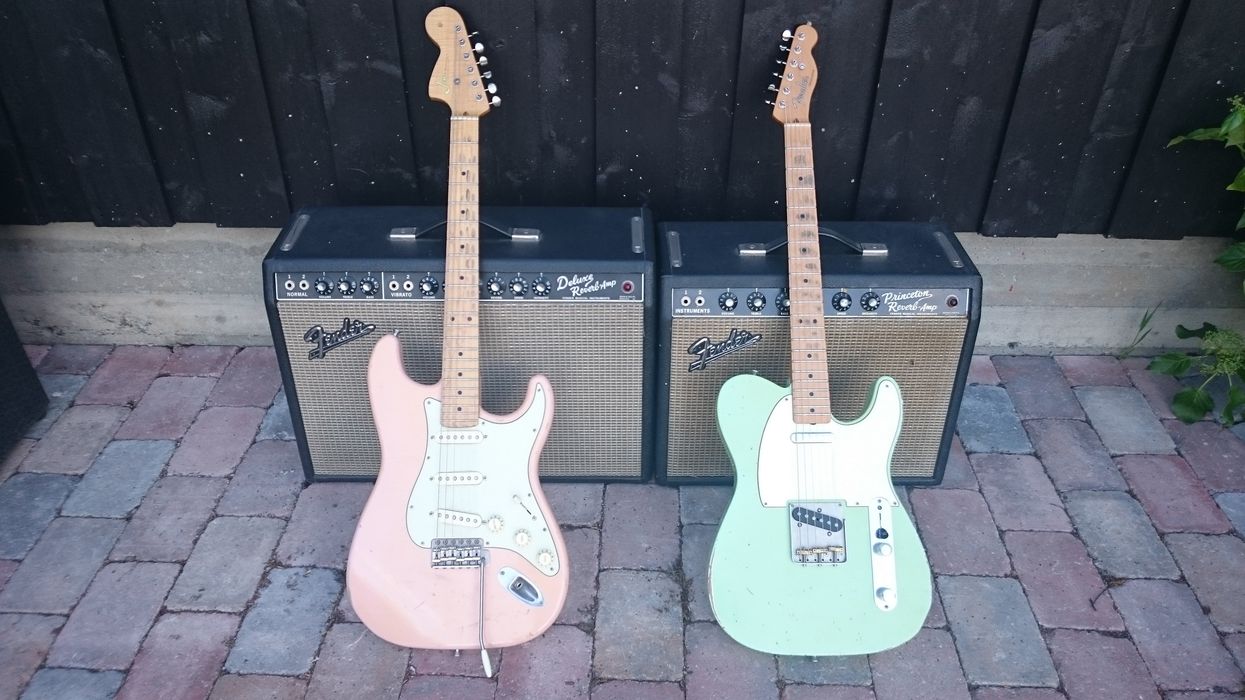
For those of you in the beginning of your Fender amp journey, there are myriad options and you might be uncertain where to start. I’ll introduce two of the most famous guitar amps on the planet: the Deluxe Reverb and the Princeton Reverb. (If you’re more experienced with Fender amps, see if you agree with my analysis of their qualities and differences.)
The Deluxe Reverb and Princeton Reverb amps were first introduced in Fender’s black-panel era (1964–1968). These amps are still made somewhat close to the originals; modern reissue models are available with either printed circuitboards or more exclusive point-to-point wiring, like their predecessors.
The strengths of both models lie in their simplicity, portability, and the much sought-after ability to break up at moderate volumes. Up to a certain point, they’ll deliver similar clean tones, characterized as the scooped Fender black-panel tone, intended to amplify the guitar as transparently as possible. Both are perfect amps for professionals and hobby players who want a stripped-down, reliable tube amp with only reverb and tremolo.
Both amps have dual 6V6 tubes in a push/pull class AB configuration, but their power amp sections are quite different. The Deluxe Reverb has a larger output transformer, a larger power transformer, higher 6V6 plate voltages, and the more efficient long-tail PI (phase inverter) circuit, versus the Princeton Reverb’s flabby-sounding cathodyne PI. The long-tail PI is widely used across 2-channel 6L6 Fender amps like the Vibrolux, Super, Twin, and Pro—the AB763 circuit amps.
The Deluxe produces 22 watts, and the Princeton a modest 12 to15 watts. Additionally, the Deluxe has a bigger speaker and a larger cabinet. The 1x10" Princeton Reverb is 16" tall, just under 20" wide, and 9 1/2" deep, weighing approximately 34 pounds. The 1x12" Deluxe Reverb is approximately 17 1/2" tall, 24 1/2" wide, and 9 1/2" deep, weighing approximately 42 pounds, and all this contributes to a louder and cleaner tone with more ambience and a bigger low end.
What does this mean? If you are looking for maximum portability and the earliest breakup, opt for the Princeton. In a recording or miked context, you won’t be bothered by its smaller, boxy tone. Plug in your Telecaster and you will be transported directly to Nashville. The Princeton Reverb can even be used with a single 6L6 tube in class A operation for ultra-low power (5 to 7 watts).
On the other hand, the Deluxe sounds slightly bigger on its own at home, in the practice room, and on stages where you need to cut through. It can even take 6L6 tubes for more power and clean headroom (about 30 watts). This 6L6 trick is not possible with the Princeton Reverb. However, the smaller Princeton is still quite capable if we do something with the speaker. It can be much louder if you swap a vintage speaker to a highly efficient modern speaker or, even better, disengage the built-in speaker and use a 1x15" extension cabinet. I love the combination of the Princeton’s early breakup through a big and full speaker cabinet loaded with a 15" Eminence Legend 1518. It’s huge and punchy, but not ear-breaking. Both amps require an 8-ohm speaker impedance, allowing a wide set of extension speakers in the range of 4 to 16 ohms.
The preamp sections of these amps are more similar, but with a few differences. The controls are the same: volume, treble, bass, reverb, tremolo intensity, and tremolo speed. Obviously, the Deluxe Reverb also has a second normal channel without reverb and tremolo. It also lacks the 47 pF bright cap, making it smoother and warmer than the vibrato channel, just like the single-channel Princeton Reverb, which also comes without this bright cap. This explains why many players think the Princeton handles pedals and bright guitars better than the Deluxe. Personally, I never use the normal channel of classic Fender amps other than sometimes routing my reverb return signal into it. That way, I can control the reverb with the normal channel’s volume and EQ knobs for more tonal options, like a dark and long reverb tone. I use a phono/jack adapter plug for this trick. Other than the bright cap, the tone stack is similar in these amps.
While the tremolo controls are the same on these amps, the tremolo circuits are built differently. The Princeton Reverb’s bias tremolo can get really deep, but only if you set the bias correctly, which can be a bit of a hurdle since it lacks an adjustable bias screw. If you struggle with weak tremolo, you can experiment with different 6V6 power tubes, rectifier tubes (either 5U4GB or GZ34, depending on the model), and 12AX7 tremolo/PI tubes (the one closest to the 6V6s). If that doesn’t help, the caps and resistors in the tremolo circuitry must be inspected. With the Deluxe Reverb’s AB763 optoisolator tremolo design, the sound is easier and more consistent.
I hope you are inspired to try out at least one of these legendary amps. I guarantee you will not be disappointed.
The Decline of Guitar Civilization?
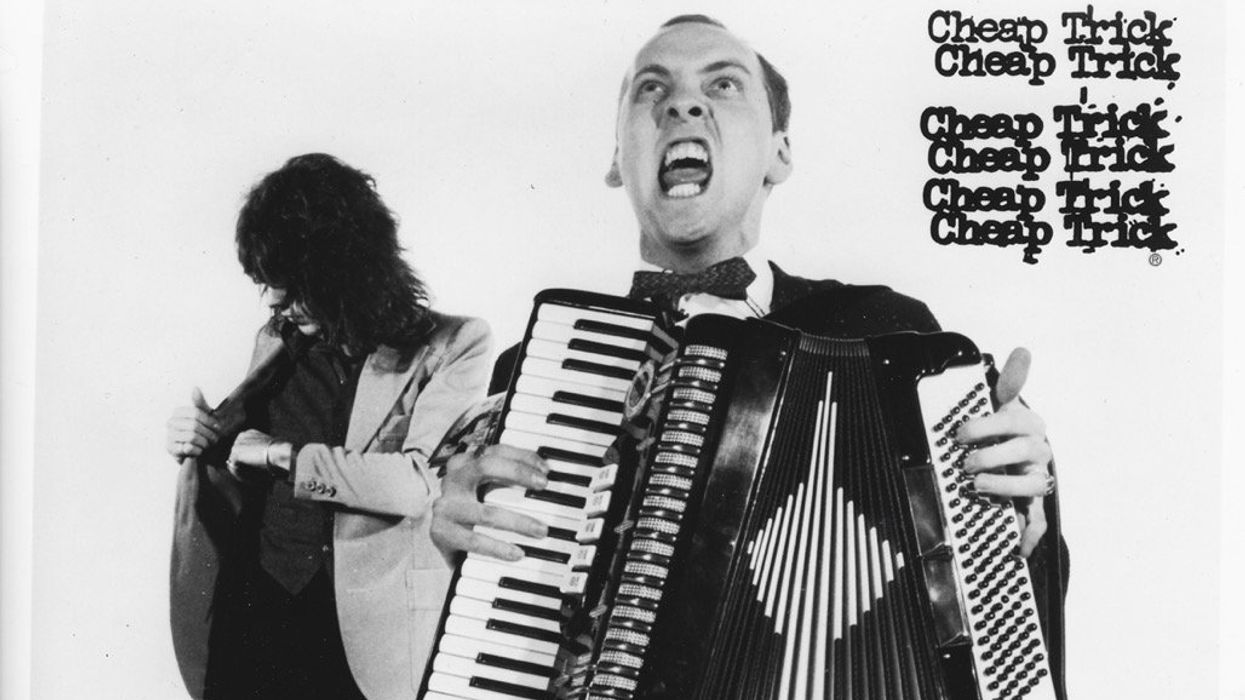
Is our favorite instrument set to go the way of the once ubiquitous accordion?
Since last month’s installment of Esoterica Electrica, I’ve been thinking about another instrument that rose and fell in the public consciousness. There was a time when the accordion was king. Not cool, maybe, but unavoidable—wheezing its way through dance halls, weddings, and smoky cafés. On TV, accordionist Lawrence Welk squeezed out over 1,000 episodes of his immensely popular show in one of the longest running serials of all time. Then, the electric guitar as we know it showed up, with its raw edges, bad attitude, and built-in middle finger, and the accordion got shoved in the closet next to grandma’s fondue set. But over the last few decades the accordion has been creeping back from the shadows, and that tells us something strange—maybe even prophetic—about where guitar culture might be headed.
The guitar has always been more than a musical instrument. It was rebellion you could strap on and crank up. It said, “I don’t care about your rules, and I’m not going to college.” Eventually, rebellion got turned into a brand. It became a logo on a shirt and a preset in a digital amp. The raw energy of rock, blues, and even jazz got scrubbed up and packaged for mass consumption. And that’s where things started to get boring. Even saturated, detuned 7-string metal got—yawn.
Guitarists might wonder if this is the decline of civilization. Probably not, but it might be the decline of a scene—the kind of place where you could write poetry about your friends, your lovers, or your city’s crumbling infrastructure. The clubs in Paris before the revolution, the jazz dives in Harlem, the punk storefronts in the Midwest—their influence was all replaced by sports bars, chain restaurants, and multi-use “event spaces.” There’s nowhere left to be inspired by place, because everywhere is the same. Meanwhile, popular music culture is drowning in junk. But that’s not new—it’s always been full of crap.
Every era had its disposable acts, cheesy hits, and manufactured stars. But now we’ve added infinite shelf space and instant access to the mix, and it’s overwhelming. Bad music isn’t the problem. It’s the sheer volume of it. Anyone with a phone can make a song, a video, and a fake album cover in 15 minutes, and then post it. And then maybe go viral. Or not. No one really knows. Algorithms don’t help, they are the sycophant friend that won’t tell you that you suck. They track clicks, not quality. In the analog days nobody knew if an album got played 50 times in someone’s bedroom—but those plays meant something. Now, we’ve turned music into data points. If it gets enough hits, it must be good, right? But we know that’s not true.
“Algorithms don’t help, they are the sycophant friend that won’t tell you that you suck.”
Now social media stumbles under its own weight. Platforms are changing their algorithms weekly, creators almost outnumber their audiences. Trends change faster than guitar strings at a sweaty club gig, and to me, the whole thing feels a bit stale. Yes, it’s easier than ever to record music, and technically that’s a good thing. But most of it isn’t great. That’s fine—most of anything isn’t great. But it’s harder than ever to find something sublime because everything’s buried in the feed. So as the accordion started to pop back up, it wasn’t just nostalgia—it was a sign that we were looking for something different. Something that didn’t feel polished to death. My observation is that music always steals from the past with a new twist. In a world that’s been flattened by sameness, an unfashionable instrument starts to seem kind of interesting again.
Which brings us back to the guitar. It still works. It still says something. But maybe now it has to fight harder to be heard. Rebellion isn’t gone—it’s just out of frame, figuring out its next move. The scene might be harder to find, but it’ll come back. It always does. Talent tends to survive, even if it doesn't trend. The guitar is a chameleon in a way that a synthesizer or computer can never be. In our hands, and strapped close to our sweaty bodies, it’s a living, breathing, organic extension of our humanity that we can twist, bend, and strangle into an emotional connection with anyone within earshot. Rock guitar was never built to last—it was meant to blow the doors off and then disappear. But that’s its super power. The guitar is like a coiled spring wound tight with the potential energy to leap back into the fray. Maybe the world is just waiting for the next weird, noisy, honest thing to kick down the door, and hopefully it has six strings and a little dirt on it.
The Decline of Guitar Civilization?

Esoterica ElectricaIs our favorite instrument set to go the way of the once ubiquitous accordion?
Since last month’s installment of Esoterica Electrica, I’ve been thinking about another instrument that rose and fell in the public consciousness. There was a time when the accordion was king. Not cool, maybe, but unavoidable—wheezing its way through dance halls, weddings, and smoky cafés. On TV, accordionist Lawrence Welk squeezed out over 1,000 episodes of his immensely popular show in one of the longest running serials of all time. Then, the electric guitar as we know it showed up, with its raw edges, bad attitude, and built-in middle finger, and the accordion got shoved in the closet next to grandma’s fondue set. But over the last few decades the accordion has been creeping back from the shadows, and that tells us something strange—maybe even prophetic—about where guitar culture might be headed.
The guitar has always been more than a musical instrument. It was rebellion you could strap on and crank up. It said, “I don’t care about your rules, and I’m not going to college.” Eventually, rebellion got turned into a brand. It became a logo on a shirt and a preset in a digital amp. The raw energy of rock, blues, and even jazz got scrubbed up and packaged for mass consumption. And that’s where things started to get boring. Even saturated, detuned 7-string metal got—yawn.
Guitarists might wonder if this is the decline of civilization. Probably not, but it might be the decline of a scene—the kind of place where you could write poetry about your friends, your lovers, or your city’s crumbling infrastructure. The clubs in Paris before the revolution, the jazz dives in Harlem, the punk storefronts in the Midwest—their influence was all replaced by sports bars, chain restaurants, and multi-use “event spaces.” There’s nowhere left to be inspired by place, because everywhere is the same. Meanwhile, popular music culture is drowning in junk. But that’s not new—it’s always been full of crap.
Every era had its disposable acts, cheesy hits, and manufactured stars. But now we’ve added infinite shelf space and instant access to the mix, and it’s overwhelming. Bad music isn’t the problem. It’s the sheer volume of it. Anyone with a phone can make a song, a video, and a fake album cover in 15 minutes, and then post it. And then maybe go viral. Or not. No one really knows. Algorithms don’t help, they are the sycophant friend that won’t tell you that you suck. They track clicks, not quality. In the analog days nobody knew if an album got played 50 times in someone’s bedroom—but those plays meant something. Now, we’ve turned music into data points. If it gets enough hits, it must be good, right? But we know that’s not true.
“Algorithms don’t help, they are the sycophant friend that won’t tell you that you suck.”
Now social media stumbles under its own weight. Platforms are changing their algorithms weekly, creators almost outnumber their audiences. Trends change faster than guitar strings at a sweaty club gig, and to me, the whole thing feels a bit stale. Yes, it’s easier than ever to record music, and technically that’s a good thing. But most of it isn’t great. That’s fine—most of anything isn’t great. But it’s harder than ever to find something sublime because everything’s buried in the feed. So as the accordion started to pop back up, it wasn’t just nostalgia—it was a sign that we were looking for something different. Something that didn’t feel polished to death. My observation is that music always steals from the past with a new twist. In a world that’s been flattened by sameness, an unfashionable instrument starts to seem kind of interesting again.
Which brings us back to the guitar. It still works. It still says something. But maybe now it has to fight harder to be heard. Rebellion isn’t gone—it’s just out of frame, figuring out its next move. The scene might be harder to find, but it’ll come back. It always does. Talent tends to survive, even if it doesn't trend. The guitar is a chameleon in a way that a synthesizer or computer can never be. In our hands, and strapped close to our sweaty bodies, it’s a living, breathing, organic extension of our humanity that we can twist, bend, and strangle into an emotional connection with anyone within earshot. Rock guitar was never built to last—it was meant to blow the doors off and then disappear. But that’s its super power. The guitar is like a coiled spring wound tight with the potential energy to leap back into the fray. Maybe the world is just waiting for the next weird, noisy, honest thing to kick down the door, and hopefully it has six strings and a little dirt on it.
Berserker Electronics Aquanaut Review
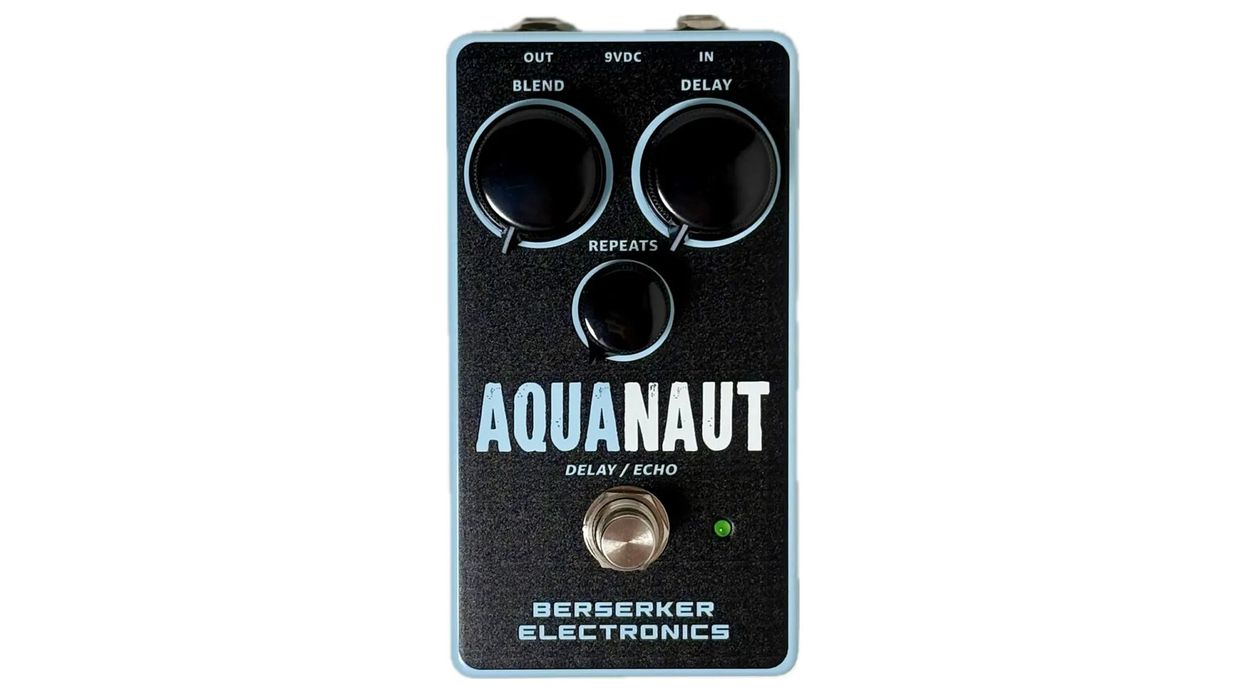
“Analog voicing” in digital delays typically refers to approximations of the foggy, frayed echoes created by a chain of analog bucket brigade devices. Digital devices aspiring to analog-ness usually accomplish this with little EQ tweaks elsewhere in the chain. And it sounds cool when done right.
Austin, Texas’ Berserker Electronics employs a multi-pronged approach to generating analog warmth from their very inexpensive, well-made, USA-built Aquanaut. To start, designer James Millican uses analog filtering at the input and output—inspired in part by the analog Way Huge Aqua-Puss and Boss DM-2. And for generating the repeats, he employs the PT2399 chip, an inexpensive and abundant digital unit originally conceived for karaoke machines that also drives delay devices like the EarthQuaker Space Spiral, Death By Audio Echo Dream 2, Caroline Kilobyte, and others categorized and marketed under the “vintage” and “lo-fi” umbrellas. This formula really works in the Aquanaut, adding an appealing analog-like toastiness that, apart from the absence of clock noise, could fool experienced analog delay users.
Deftly Walking the Digital Divide
The few limitations in the Aquanaut design have little bearing in basic delay applications. If you use oscillation effects at high mix and repeat levels, however, you might find the Aquanaut’s controls feel a little uptight compared to true BBD effects. Some users might like this less twitchy and temperamental feel. But it’s likely everyone can appreciate the generously proportioned and easy-to-manipulate blend and delay knobs, which facilitate hands-on Nigel Godrich flying-saucer-liftoff effects, Jimmy Page Echoplex manglings, and other outer-limits oscillation-based sounds.
“The Aquanaut responds to dirty, distorted tones in the same visceral, haunted way a BBD device does.”
As for the repeats, they’re warm and contoured at the edges, with a little more capacity for midrange detail than the Supa-Puss and Carbon Copy I used for comparison. That said, there is haze aplenty. By pushing the PT2399 beyond its usual 300ms maximum repeat time spec, Millican introduced some distortion to the repeats. The analog input stage filtering, meanwhile, removes some of the high frequencies in that distortion. There’s also a diode limiter before the delay chip. This recipe adds a lot of the ambience—some might call it signal pollution—that makes real bucket brigade echoes sound so hazily mysterious and immersive. I’d be lying if I said I didn’t hear slightly more of this ambience in the repeats of a Supa-Puss and Carbon Copy. But the Aquanaut’s version is pleasing and practical in other ways. And like my real BBD echoes, the Aquanaut responds to dirty, distorted tones in the same visceral, haunted way a BBD device does—rounding off edgy harmonic peaks and adding a very open compression that allows plenty of room for aggressive picking dynamics.
The Verdict
At $129, the Aquanaut is just $20 less than the genuine bucket brigade MXR Carbon Copy and the same price as digital delays like the TC Flashback, which features a less dimensional “analog” simulation. Yet it’s a high-quality pedal, and the compromises inherent to this kind of design are executed in a way that doesn’t require many sacrifices in sound, quality, or value. James Millican and Berserker pulled off a nice balancing act here—assimilating virtues from great, straight-ahead BBDs without the clock noise, and with a little extra headroom and midrange fidelity that dovetails beautifully with drive, distortion, and fuzz.
The Boss RT-2 Rotary Ensemble Demo
Mysterious modulations and Leslie sounds abound in a compact, straightforward, and streamlined rotary simulator complete with variable drive settings.
BOSS announces the RT-2 Rotary Ensemble, the latest member of the company’s famous compact pedal lineup. Rotary speaker cabinets are a vital part of the classic combo organ voice, and guitarists and other musicians have also used them to infuse iconic tracks with their distinctive depth and rich modulation. Powered by the latest BOSS advancements, the RT-2 distills this expressive spatial effect into a pedalboard-friendly footprint with three sound modes, deep tonal shaping, multiple audio output configurations, and advanced real-time sound control.
The most revered rotary speaker designs feature a spinning high-frequency horn (treble rotor) and a woofer that feeds into a rotating drum (bass rotor). Changing rotor speeds between fast and slow creates a steady stream of tonal shifts that players have long used for interesting sonic movement. The RT-2 authentically replicates these complex audio behaviors, coupled with two-way speed control, a Rise/Fall Time switch for adjusting the transition time between speeds, and a colorful indicator that shows the current rotation of the virtual rotors.
The versatile RT-2 has a three-position Mode switch for selecting a classic rotary speaker sound or two modern variations developed with custom BOSS tuning. There’s also a Drive knob to add pleasing distortion inspired by the tube amplification circuits in vintage rotary speaker cabinets. Via a rear-panel switch, this dual-function control can be assigned to adjust the volume balance between the treble and bass rotors for different tonal characteristics.
Boss RT-2 Rotary Ensemble Pedal
RT-2 Rotary Ensemble Pedal
PRS Guitars Releases Two of Its Most Popular Pickups for Sale as Stand-Alone Parts
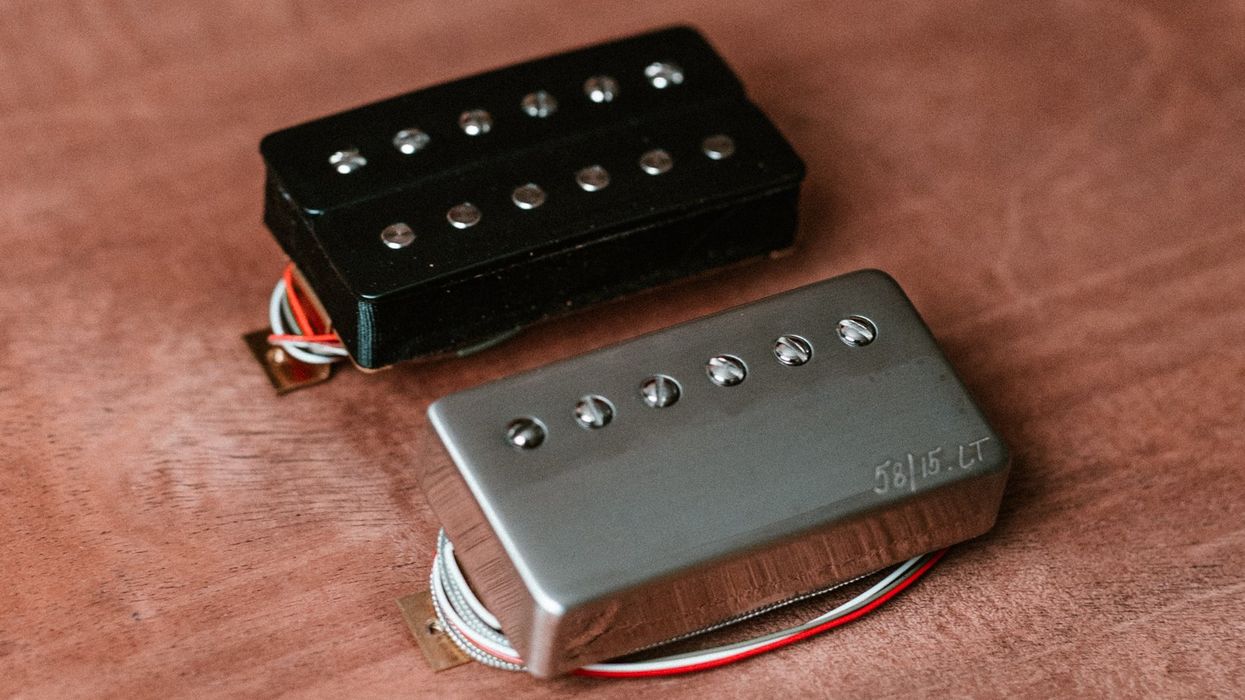
PRS Guitars today announced that their renowned 58/15 LT and 85/15 pickups are now available aftermarket from authorized PRS dealers and directly through the PRS West Street East online store.
PRS 58/15 LT (“low turn”) pickups are vintage-inspired pickups with exceptional clarity. Designed to capture the sweetness of vintage single coils and the warmth of late 1950’s humbuckers, these pickups are lively and open with focused midrange and balanced treble and bass.
PRS 85/15 pickups bring modern and vintage pickup design together to deliver exceptional clarity and extended high and low end. With balanced full-spectrum clarity, PRS 85/15’s are perfect for modern players driving a pedalboard and have enough character to deliver when plugging straight into an amp.
The music industry continues to take notice of PRS pickup designs. When describing the 58/15 LT pickups, guitar content creator Sean Daniel recently said, “The balance of PRS pickups is probably my favorite part. They’re warm and bright at the same time … there’s a distinction between the frequency bands that you get with the PRS stuff that is awesome.”
Earlier this summer, PRS also introduced new apparel, hats and lifestyle offerings, along with a range of parts now available for individual purchase. The popular PRS Rechargeable Clip-On Headstock Tuner has also been updated to charge via USB-c for more convenience. As always, you can find genuine PRS accessories at any Authorized PRS Dealer and, in the USA, online in the PRS West Street East accessories store.
“This summer’s accessory releases include options for everyone from the casual player to pro musicians who use our gear on stages worldwide. We are especially excited to offer our 85/15 and 58/15 LT humbucking pickups for sale as a pair or as individual options,” said PRS Guitars Director of Marketing, Judy Schaefer.
PRS Guitars continues its schedule of launching new products each month in 2025. Stay tuned to see new gear and 40th Anniversary limited-edition guitars throughout the year. For all of the latest news, click www.prsguitars.com/40 and follow @prsguitars on Instagram, Tik Tok, Facebook, X, and YouTube.
It’s Time To Crash Your Component Stash!
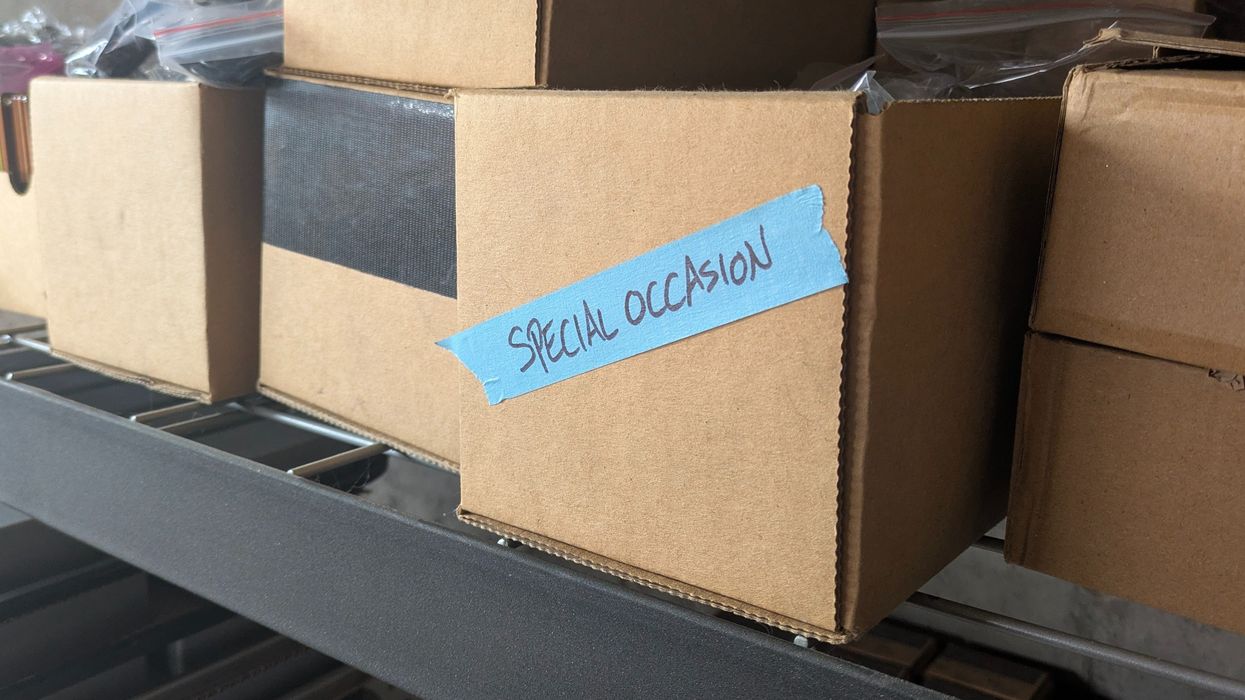
Does the uncertainty of tariffs provide an opportunity for builders who’ve been collecting vintage, rare, and favorite electronics to turn them into cool, premium pedals?
I’ve been thinking recently about the state of electronic components as it pertains to imports and tariffs. Now, before you get turned off, this will be from a manufacturing perspective and not a political one. This is actually in line with my very first article about supply-chain issues, from the March 2022 issue.
I feel pretty confident saying that most of us pedal manufacturers are collectors and enjoyers of components—especially vintage and rare ones. Quite possibly to the extent that it encroaches on pack-rat behavior. I’m no Analog Man, but I have personally accrued components for a variety of reasons: discontinued models, overstock, vintage coolness, and even wishful thinking. These components typically sit dormant, patiently waiting for their chance to be called up to the big show, all the while looking on from the sidelines as standard production components rule the roost.
So, how do these components play a role in the conversation as it pertains to tariffs? Well, as we monitor the rollercoaster that is import tariffs on foreign goods, it makes me think about looking internally. Now, that’s not me subtly implying a “make the stuff in America” ideology. It’s more about taking stock of the component collections already here and creating what we can with what we have. It’s the practice of creating when working within limitations—the antithesis of option paralysis. When you’re given limitations, it often breeds creativity in a healthy and productive way.
Up until a few years ago, I had been collecting a bin of special parts. This bin ranges from cool transistors to germanium diodes to bags of my personal favorites, tropical-fish capacitors. These are caps that I scrub through internet marketplaces to procure. They aren’t prominent in any current products, but for me they fall into that aforementioned “wishful thinking” or “one of these days” categories. It’s the equivalent of a hutch or cabinetry to accommodate a fine china collection—those plates you never use because your mom was saving them for special occasions, and now they’re yours.
As much as I appreciate the idea of a special occasion, that concept can lead to an idea or project being placed on the back burner indefinitely—shades of the saying “perfect is the enemy of done.” There may never be an occasion that is deemed special enough. Let’s also remember that we are the givers of value and one person’s mundane is another’s special occasion.
“When you’re given limitations, it often breeds creativity in a healthy and productive way.”
You’ve probably heard enough philosophical cork-sniffery from me for one article, so let’s get back to pedals and components! Now the joy for these components is not just the province of builders; it’s also often important to players. To reference Analog Man again, when looking at ordering options for a Sun Face fuzz from their website, I was presented with 18 transistor options. This helps corroborate the idea that players get on the same nerd level as builders. Both share a joy for these little electronic components. Choosing your pedal-to-be’s transistors is the same thing as your friend that’s a car nut ordering custom parts from a small body shop.
Creativity is something I would categorize as an unstoppable force. Much like how Dr. Ian Malcolm said “life finds a way” in Jurassic Park, I say creativity demands an outlet. Suppression is futile. So let’s bring it back to those fancy dinner plates in the hutch. They’re screaming to be used and not just left on a trajectory of an unfulfilled future.
The thought of this unfulfilled future is something that sticks in my head. It makes me take that image of plates and replace it with that bin of components. That, compounded with import difficulties, leads me to more aggressively entertain the idea of moving forward with that bin of parts and bring something fun to life. Perhaps these tariffs are the catalyst us pack rats need; perhaps we’re ready to take that fine china out of the hutch.
Al Nesbitt & the Alchemy Drop Latest Single “The Lost Night” as Part of “Live in Seattle” EP
Trending instrumental guitarist Al Nesbitt and his all-star band deliver their newest track to fans everywhere.
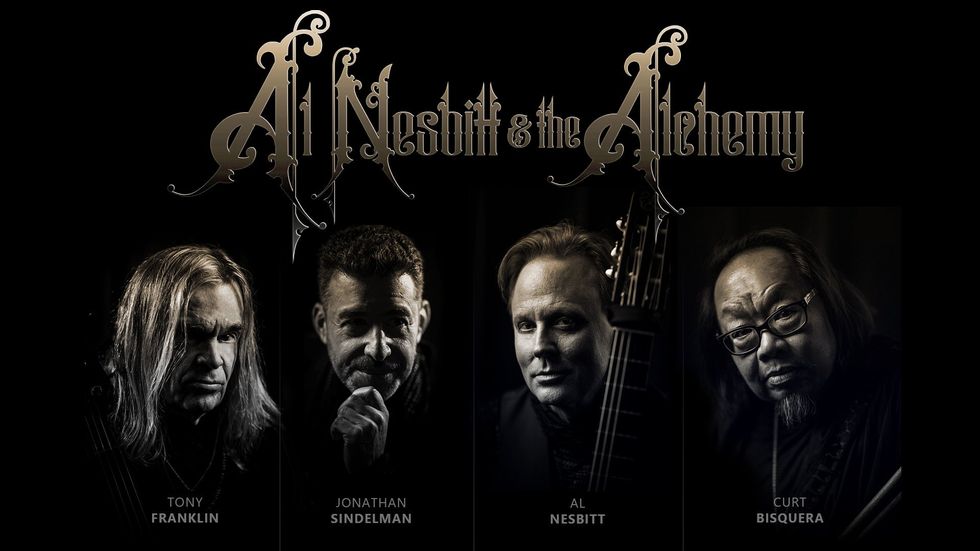
The band announced its latest independently-released single is an original composition penned by Nesbitt that includes memorable melodies—all captured and mixed byGrammy award recipient, Steve Smith. An all-new music video accompanies the single and can be found on the band’s YouTube Channel.
Nesbitt comments, “Steve’s work has been just beautiful. Everything has its own space in the mix, but each track becomes very cohesive and big when it needs to be.
”The legendary “Fretless Monster” Tony Franklin of The Firm, Blue Murder, Kenny WayneSheppard, David Gilmour and Kate Bush fame provides world class bass lines with his signatureFender Fretless Precision Bass.
Completing the rhythm section is ace studio drummer, Curt Bisquera. Kirkee B as he is also known, has played with notable artists including Tom Petty, Mick Jagger, Elton John and ChrisIsaak. Bisquera and Franklin lock in a solid foundation for Nesbitt’s nylon string solos and hooks.
Keyboardist extraordinaire, Jonathan Sindelman completes the four-piece ensemble and has contributed to the music of GooGoosh, Alan White Band, Furious Bongos, Element Band. Sindelman’s impressive solos are featured throughout the “The Lost Night” as well as the “Live in Seattle” EP.
Follow Al Nesbitt and the Alchemy on Facebook and Instagram. “Live in Seattle” including “TheLost Night” and first single “Room 53” can be streamed on Spotify.
Marty Stuart: Outside of Nashville and Into the Cosmos
In the pantheon of popular country music artists, Marty Stuart has always been both an anomaly in Nashville and one of the genre’s biggest champions. How else to define the man who scored a 1992 hit with “Now That’s Country,” a twangy paean to the virtues of a simple rural life, while the same year humorously eschewing the Nashville signifier of the day, the cowboy hat, on his No Hats Tour with Travis Tritt?
Meanwhile, behind the scenes he was quietly amassing the largest known private collection of country music memorabilia in the world—which, of course, includes more than a few cowboy hats alongside rhinestone-studded Nudie suits, handwritten song lyrics, classic musical instruments, and a century’s worth of ephemera.
And despite earning bulletproof bonafides by serving as a sideman to country-music pillars Lester Flatt and Johnny Cash, tours of duty that occupied more than a dozen years and turned him from a teenage prodigy to a touted major-label artist, his interests outside of Nashville have become a large part of his musical life.
On his first full album of instrumental songs, the new 20-tune collection Space Junk, recorded with his longtime co-conspirators the Fabulous Superlatives, Stuart shows exactly why he was never fully Nashville’s guy in the first place. “In my original record collection, there were several records by the Ventures and Herb Alpert and the Tijuana Brass,” Stuart says of his adventurous early musical loves, both of which left a sizable sonic imprint on Space Junk.
In the ’60s, instrumental groups were common on the charts, and Floyd Cramer’s wordless 1960 hit, “Last Date” was a mainstay in Stuart’s childhood home in Philadelphia, Mississippi, alongside the bluegrass he was devouring and quickly mastering. “Instrumentals were just part of the language that I grew up listening to,” he says.
Marty Stuart’s Gear
Guitars
1954 Fender Telecaster with B-bender (“Clarence”)
1956 Gretsch 6120
1967 Fender Kingman (Nashville tuning)
1939 Martin D-45
Amps
Fender Deluxe with power boost mod
Strings and Picks
D’Addario NYXL or Nickel Wound, various gauges (electric)
D’Addario Phosphor Bronze, various gauges (acoustic)
Fender medium tortoise shell picks
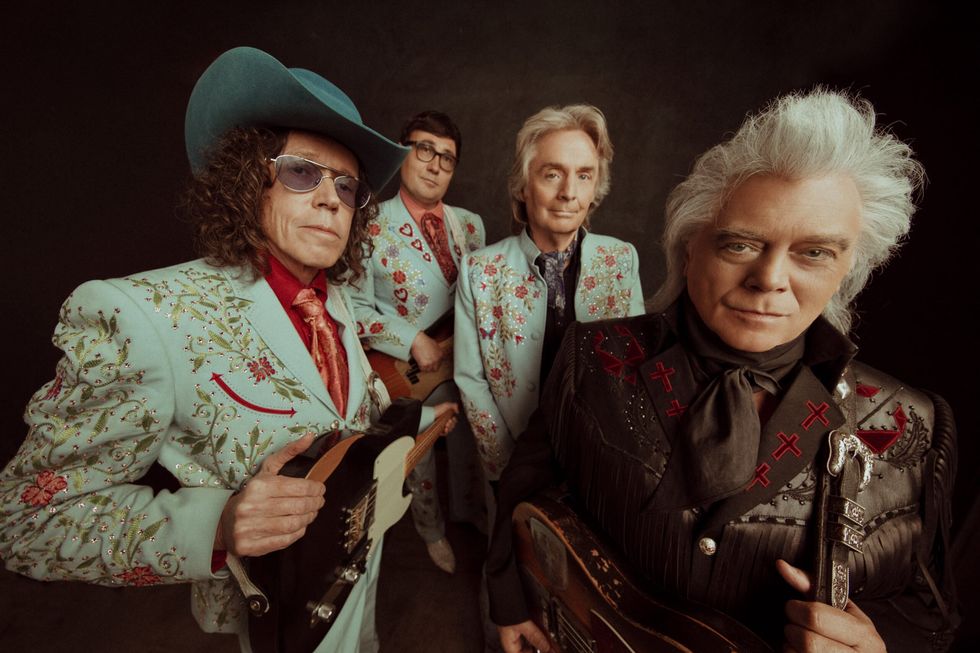
Kenny Vaughan’s Gear
Guitars
RS Guitarworks Kenny Vaughan model
Fender Mike Campbell Red Dog Telecaster
1961 Fender Jazzmaster
1999 Martin HD-28
1983 Fender Squire Stratocaster
1993 Rickenbacker 360/12V64
Amps
Fender Princeton
Marshall JMP PA20
“The minute I stepped out of chasing one record or one style of record down two streets in Nashville and got back into being a world-class musical citizen rather than just being a hit-chasing hillbilly, it opened up the sky.”
With a lifetime’s worth of musical range already percolating, Stuart entered the trade himself at age 12 as a mandolinist in the employ of bluegrass pioneer Flatt. Instrumental flair was part of the set in those days, encouraged by the marquee names themselves. “Everybody knew that Johnny Cash was a star and Lester was a star, but there was a turn every night where everybody had their moment,” Stuart says. He took the experience as training, and the Superlatives—guitarist Kenny Vaughan, multi-instrumentalist Chris Scruggs and drummer Harry Stinson—have carried on the tradition from day one. “Everybody can step up and run the show without breaking a sweat, and it spoils me to pieces to have people like that around me.”
Stuart has made a habit of being an enthusiastic collaborator. When his solo recording career took off with his 1989 album, Hillbilly Rock, the first in a three-album run of Gold-certified records, he followed it by co-writing the Grammy-winning “The Whiskey Ain’t Workin,’” which he and Tritt recorded together in 1991. The duo repeated the trick on “This One’s Gonna Hurt You (For a Long, Long Time)” the next year.
But after pursuing hits, Stuart aimed for another level of expression and storytelling with The Pilgrim, an ambitious concept album built around a love-triangle narrative. While the project was one of his least commercially successful endeavors, it marked the arrival of a new regimen for Stuart. “The minute I stepped out of chasing one record or one style of record down two streets in Nashville [a reference to the city’s home of industry, Music Row] and got back into being a world-class musical citizen rather than just being a hit-chasing hillbilly, it opened up the sky,” he says.
What pulled him out of the morass was scoring All the Pretty Horses, the 2000 film adaptation of the Cormac McCarthy novel, which he credits with teaching him about painting without words. “The visual and the sonic worlds have to dance together,” he says. “It all comes down to whether it moves somebody or it doesn’t. It comes from the heart or it doesn't.”
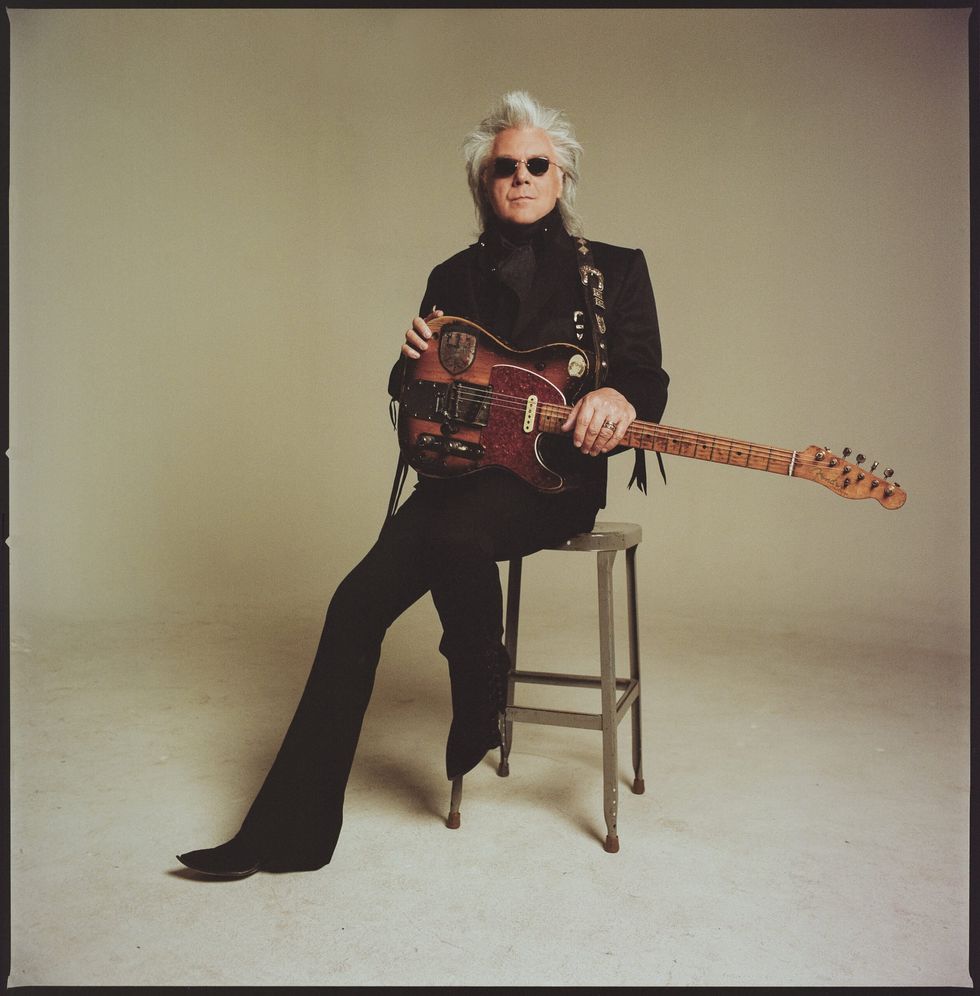
When Stuart assembled the Fabulous Superlatives to back him on the 2003 album Country Music, he found the band that could fully express his vision of a boundless group rooted in country but willing to explore the outer limits of their sonic tapestry. To wit, Space Junk wasn’t conceived in a conventional series of studio sessions. Rather, it shows how deeply down the rabbit hole the band members were willing to go from the jump.
“We really didn’t set out to write an instrumental record,” Stuart explains. “We just kept making up songs that made us smile and we enjoyed playing on stage. It turned us back into kids with our first Fender guitars, and that’s the truth.”
The songs on Space Junk predate both 2023’s cosmic country-rock Altitude—recorded after backing the Sweetheart of the Rodeo 50th anniversary tour with the Byrds’ Chris Hillman and Roger McGuinn—and 2017’s trippy, high-desert hallucination Way Out West. Informed by his childhood influences, many of which he shares with his bandmates in the Fabulous Superlatives, Space Junk cracks open the cinematic sweep of Stuart’s musical universe.
Opening the album with a reverb-rattled surf lick, “The Graveyard” begins the immersion into the group’s interplanetary soundscape. Stuart gets out further with the mindbending leads on “Bat Patrol” and pulls high drama into the wide-open Western skies of “All the Pretty Horses.”
“I get up and see what [the guitar] has to say that day, and it’s always wonderful to learn a new lick or a new chord that actually works somewhere,” he says. “Songs are what bring those things about easily for me.”
“We just kept making up songs that made us smile and we enjoyed playing on stage. It turned us back into kids with our first Fender guitars.”
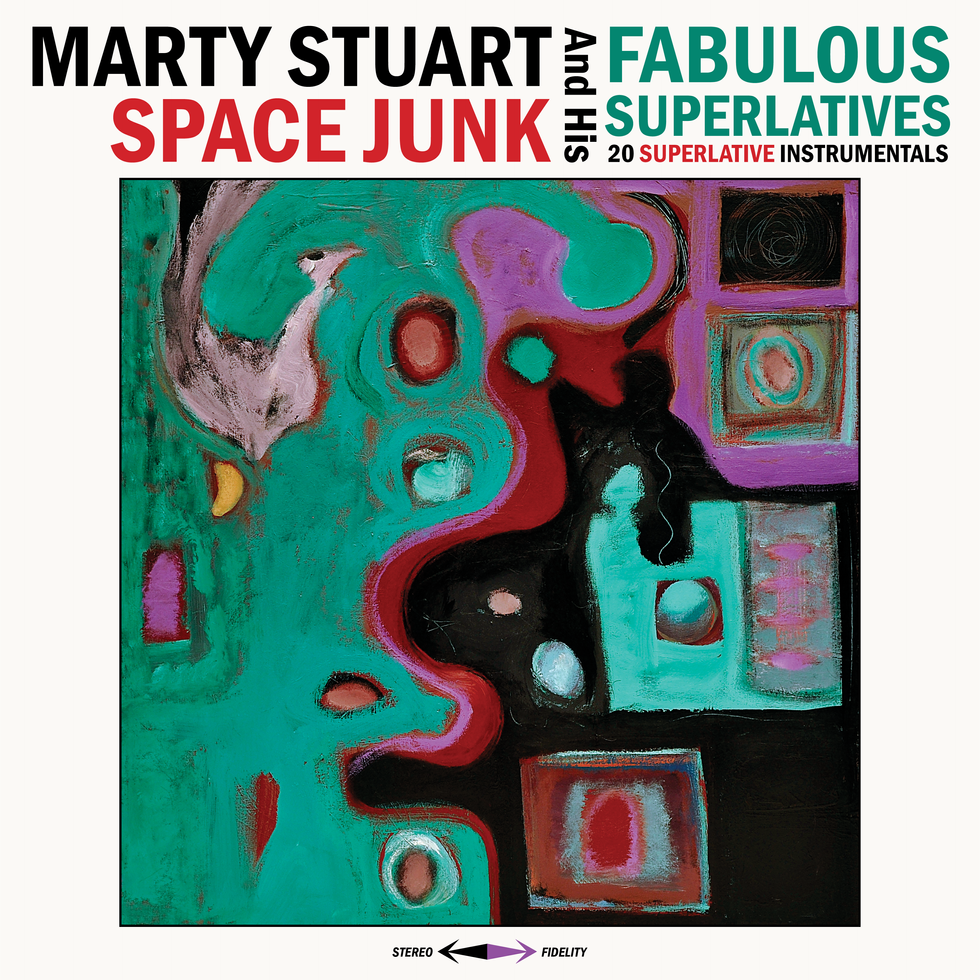
The Vaughan-penned tunes “The Surfing Cowboy” and “The Ballad of the Lonely Surfer” are opposite sides of the same coin. Although both are rooted in Ventures-style surf music, the latter is built around a tremulous chord progression and melody while the former is an upbeat tune with bright, Byrdsian passages bookending leads by Vaughan and Stuart, who played a 1967 Fender Kingman in Nashville tuning. Stinson and Scruggs also contributed songs to the project, with Scruggs playing the prominent pedal steel on closer “Waltz of the Waves” and lead guitar on “Slipnote Serenade,” both of which he wrote, and Stinson writing and arranging strings on the title track.
“The thing I admire about this record is that it’s really melodic in a world where there’s a thousand notes a minute flying at you from the hottest guitar players in the world,” Stuart says. “And trust me, everybody on this bandstand can slay you with 1,000 notes a minute. But something that shows a lot of wisdom and a lot of maturity as a player is air, and there’s a lot of air on this record, and the melodies are hummable.”
Irony is a certified guitar slinger who owns a vast collection of country-music artifacts but only keeps “a couple of acoustics” at his home, like the pre-war Martin D-28 with “a real skinny neck that sounds like a cannon” that Stuart often picks up. His only amplified rig around the house isn’t even for a guitar. It’s a Buck Trent electric banjo and Sho-Bud amplifier.
Among his storied collection are Johnny Cash’s personal gloss-black Martin D-35, A.P. Carter’s 1936 Martin 000-28, a rosewood Fender Telecaster owned by Pops Staples and given to Stuart by daughters Mavis and Yvonne Staples, and guitars that once belonged to Carl Perkins, Charley Pride, and Merle Haggard. But while Stuart, one of Nashville’s great sidemen-turned-stars, may own an army of guitars, he only used a handful of his workhorses to make Space Junk. Arguably, the most historic guitar he owns is the one most associated with him now, the 1954 Fender Telecaster modified by Gene Parsons and Clarence White with the first B-bender.
“Every time I pick it up, there’s something to learn,” he says, “and that guitar still knows a hell of a lot more about me than I know about it. But I love playing it; I love the sound of it. I love the way it feels. But to tell you the truth, every time I think I’ve really got something going on, I hear some tape or some record that Clarence played on. Then, ‘No, back to the woodshed.’ It’s amazing to think that he died when he was 29 years old and he really had it on the run.”
Stuart also used a 1958 Gretsch 6120 hollowbody and a 1939 Martin D-45 to complement Vaughan’s RS Guitarworks signature model, a 1983 Squier Strat, a ’61 Jazzmaster, and a Mike Campbell signature model Telecaster.
“My rig is as straight ahead as Willie Nelson’s rig or Bill Monroe’s mandolin,” Stuart says. “I have a silverface Deluxe amp, and it has a power boost on it and an EQ that I couldn’t operate if my life depended on it.” For Stuart, the magic is in the guitars themselves. “If you plug that Clarence White guitar into any amp on planet Earth, it’s still gonna sound great. If you plug that Gretsch 6120 into any amp on planet Earth, it’s still gonna sound great. My sound is those guitars.”
Now in his sixth decade as a professional musician, his formerly black mane a shock of textured grays, Stuart is still reliably inclined to zag when the industry zigs. Having a band of virtuoso players on his side helps when he’s ready to make his next move.
“Being a part of this band, there’s nowhere they can’t go, legitimately,” he says. “If you can think it up, it can get played here. It makes the world a whole lot more interesting.”
YouTube It
Marty Stuart and Kenny Vaughan tear it up in a vintage appearance on Late Night with David Letterman.
Kenny Vaughan—Stuart’s 6-String Foil
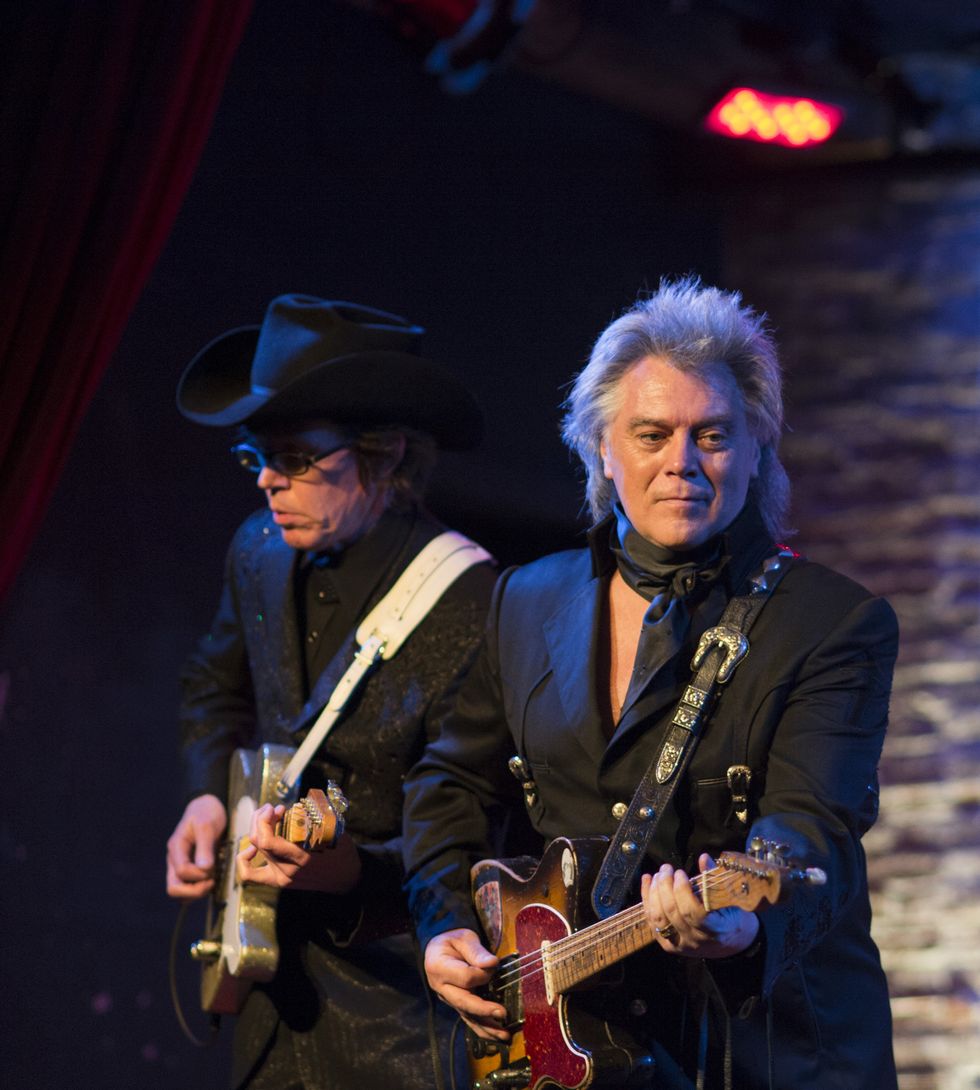
Longtime Superlative sideman Kenny Vaughan isn’t your typical country guy who geeked on the Nashville sound as a kid. But on exploratory records like Space Junk, where versatility and imagination are part of the gig, his background has been a boon.
“I grew up listening to jazz [and took lessons from Bill Frisell], and then I got into Frank Zappa records and all kinds of stuff that has nothing to do with country music,” he says. Yet, Vaughan developed a soft spot for honky-tonk tunes during his childhood in the late ’50s and early ’60s. “I’ll never forget the first time I heard Ernest Tubb. My head exploded. I was like, ‘This guy is from outer space.’”
By the time he picked up a guitar, the AM radio airwaves were awash in instrumental music. “They would always play an instrumental right before the news report at the top of the hour, so you’d hear ‘Rumble’ by Link Wray or ‘Walk Don’t Run’ by the Ventures,” he says. His first performance was a neighborhood recitation of surf tunes with other local kids, and later, when he formed a band of his own, they would open shows with the Ventures’ “Cruel Sea.”
Vaughan took his own circuitous route to Nashville, arriving in 1990 just as the hat acts—superstars like Garth Brooks and Alan Jackson—rose to prominence. He eventually found his place in the rowdier rooms of Lower Broadway and toured with Lucinda Williams before hooking up with Stuart in 2002. For more than two decades now, Vaughan and his Fabulous Superlatives bandmates have built up a mutual trust working within Stuart’s expansive musical landscape.
“Everybody in the band brings a lifetime of in-the-studio experience to the table, so when we work up tunes it’s pretty easy to fall into playing the right parts,” he says. “Every song is different, and rarely will we use the same starting point.”
The songs on Space Junk are a case study in how the group functions. All four musicians contributed songs and collaborated across its 20 tracks, and no one was uptight about taking cues from the others. On a few occasions, when Vaughan dialed up the “stratosphere tuning” made famous by Jimmy Bryant—a 12-string-specific configuration in which the doubling strings are tuned up a third instead of an octave—Stuart, with his encyclopedic knowledge of country-music instrumentation, was there to help guide his parts.
“Marty helped me work out the solos, because none of the notes were where they’re supposed to be,” he says. “When you play that tuning, you have to relearn the neck and compose your solo. I’d sit in the control room, and he’s sitting right next to me and saying, ‘No, play this.’ It was done on the fly, but he kind of produced me.”
Challenges sometimes came from his own tunes, like “Malibu Dawn,” which uses polychords. “I heard it in my head,” he says, “and I took a couple of days to work it out to where I could present it to the guys and walk them through the whole idea.” The band learned and mastered the tune, then put it on tape. “Some tracks play themselves, and boom, it’s done,” he says. “Others take a lot of work.”






